













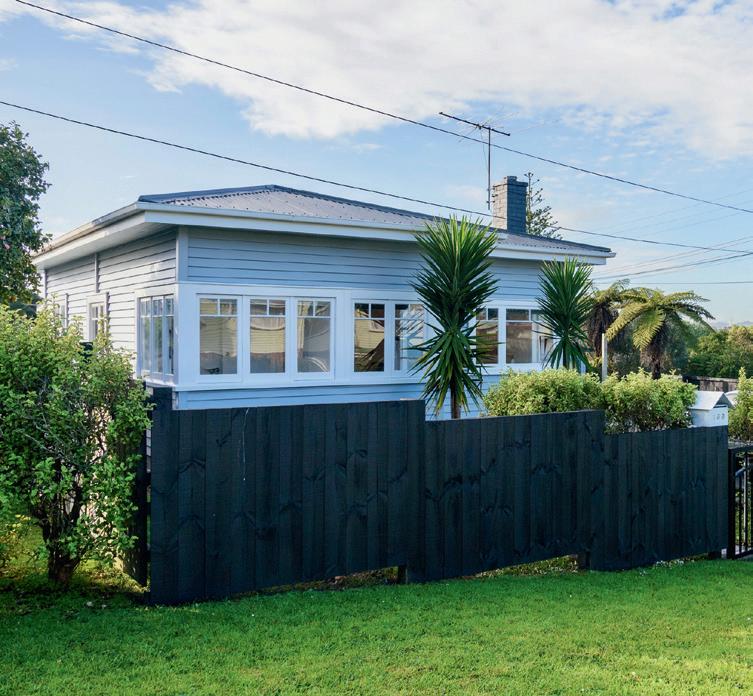




























Would regulation of the sector prevent unscrupulous property managers from engaging in illegal activity?
There’s been many headlines about landlords operating outside of the Residential Tenancies Act’s (RTA) regulatory framework recently. Unscrupulous operators who prey on migrants’ lack of understanding of tenancy laws – housing them in freezing caravans and illegal boarding houses.
The stories are perfect clickbait, and these fringe figures should never be seen as exemplars of the wider industry. They operate in a black market –a “shadow industry” lurking beneath the surface of the mainstream.
Our lead story addresses this property management underbelly. We discover a shadow industry dedicated to exploiting new arrivals to New Zealand – many of whom can’t speak English and come from countries where tenancy laws are non-existent.
These activities exist within an unregulated market. And while there will always be rogue operators and those who exist on the fringe, wouldn’t a regulated sector, and the associated threat of enforcement, raise standards across the board?
The industry experts that we interviewed are unanimous in their call for regulation.
And it’s not just about tenant protection. David Faulkner from Property Brokers believes that if landlords were aware of the ad hoc nature of money management in some firms, they would be more vocal about the need for regulation.
As he explains, Property Brokers has a trust account that houses clients’ money; and it is regularly audited.
“But many companies don’t have trust accounts. And there’s no compulsion for them to do so. All it would take is one rogue employee to put landlords’ money at risk.”
There are whispers that regulation may be on the horizon. It will be a welcome development for the professional property managers who do a wonderful job of balancing tenants’ and landlords’ needs in an increasingly complex regulatory environment.
Our profile this issue, Nicola Valentine, is adept at finding opportunity in complexity.
Her journey has been complex – she’s dabbled in development, created high-quality boarding houses, and now owns Movapod, a transportable small-home company that offers investors the chance to add value to their existing properties.
She’s navigated the ups and downs of the market and has some great insights into investment success. We are sure you will enjoy her story.
Thanks for reading and enjoy the spring weather.
Many
thanks
Joanna Mathers

NZ PROPERTY INVESTOR
MAGAZINE PUBLISHER
Informed Media Limited PO Box 40128, Glenfield, Auckland 0747
PUBLISHERS
Joanna Mathers and Sally Fullam
EDITOR
Joanna Mathers E joanna@informedmedia.co.nz
DESIGN DIRECTOR
Sally Fullam E sally@informedmedia.co.nz
ACCOUNT MANAGER / ADVERTISING SALES
Joanna Mathers E joanna@informedmedia.co.nz M 021 250 7101
WRITER
Sally Lindsay
PROOFREADER
Síana Clifford
SUBSCRIPTIONS
Sally Fullam
Online nzpropertyinvestor.co.nz
E subs@informedmedia.co.nz
PH 022 431 9144
TO SUBSCRIBE GO TO nzpropertyinvestor.co.nz/subscribe
NZ Property Investor has been printed on accredited and fully recyclable paper sourced from sustainably managed and legally harvested forests.
NZ Property Investor sources expert advice on a range of specialist topics. We recommend you get your own independent advice before you take any action, and any action you take is strictly at your own risk. Opinions expressed by contributors are not necessarily those of NZ Property investor or Informed Media Ltd. Informed Media is not liable for any loss or damage (included but not limited to indirect or consequential loss) or for personal injury arising from any action taken.
© 2025 • Informed Media Limited Issue 258
NZ Property Investor is published by Informed Media Limited. The contents are copyright and may not be reproduced without the consent of the Editor. All rights reserved.



Carole Pedder
With over two decades of experience as a chartered accountant and business consultant, Carole is dedicated to understanding her clients’ businesses and providing strategic guidance for sustainable growth.

Debbie Roberts
Debbie Roberts is a financial adviser with 25-plus years’ property investment experience. She co-founded Property Apprentice in 2010 with her husband Paul to help others achieve financial freedom through property investment.

Shadi Salehpour
Shadi is the owner of Let’s Rent, an award-winning property management company in Auckland known for its personalised approach and commitment to excellence. With a passion for fostering strong relationships between landlords and tenants, Shadi has built a reputation for integrity, innovation, and professionalism in the industry.

Sarina Gibbon
Sarina is an independent tenancy consultant, industry advocate and established media commentator. Her clients include the Auckland Property Investors Association, Renti and several property management organisations.

Matt Ball
Matt Ball is PR and advocacy manager for the New Zealand Property Investors Federation. Matt has decades of experience in PR and politics, is a property investor and has been a renter. These experiences help him represent and advocate for property investors and push for policy changes that benefit the whole industry.

Caleb Pearson
Former winner of The Block NZ Caleb Pearson pursues real-life renos with his wife Alice and documents the progress through their blog, social media and New Zealand Property Investor

Eve Prouse
Eve Prouse is a trusted property valuer and respected media commentator specialising in Auckland property markets – in particular South Auckland. Of Pacific heritage, Eve brings a unique, communityrooted perspective to her work.

David Faulkner
David is the general manager of property management for Property Brokers and is recognised as one of the leading experts in the New Zealand property management industry. He has been involved in the industry developing robust policies and procedures, training, and consultation services for many years.

Paul Money
Paul Money worked for 19 years at LINZ as a property rights analyst, spent six years at a top-tier law firm in Auckland and 11 years at a boutique corporate law firm in the city. He is now an associate at Land Law.

Leonie Freeman
Leonie Freeman is the chief executive of Property Council New Zealand. She has extensive experience in the property industry, having held top positions in both the public and private sector. From creating the concept of what is now realestate.co.nz, to buying and transforming her own residential property management business, she is a leading light in the industry.

Kris Pedersen
Kris Pedersen of Kris Pedersen Mortgages is a commentator on property and finance. His team sources top finance strategies.

Rachel Radford
Rachel Radford is the marketing lead for builderscrack.co.nz, New Zealand’s largest home improvement platform that connects homeowners with tradespeople. Her journalism background, combined with the platform’s comprehensive industry data, provides unique perspectives on nationwide property repairs and renovations.

Townhouses and apartments will dominate Auckland’s skyline and standalone houses sink into the shadows if the government’s new urban development plan for two million houses eventuates, S ally Lindsay reports.
Data from Auckland council shows standalone houses will shrink from 62 per cent of the city’s housing stock to just 27 per cent, while townhouses and apartments will surge from 36 per cent to dominate at 70 per cent.
About 326,000 existing standalone homes currently make up the majority of the city’s housing, compared to about 190,000 terraced homes and apartments.
Over the coming decades, the capacity for terraced homes and apartments is projected to rise to about 370,000, while the number of standalone houses will drop to just 140,000.
This turnaround will come from Auckland’s new draft plan spearheaded
by
RMA Reform Minister, Chris Bishop, which enables 10 and 15-storey apartments within a 10-minute walk of 44 town centres, train stations and rapid bus stations.
It will be a massive shift in how Aucklanders live and it hasn’t gone down well in Auckland’s leafy suburbs resplendent with villas from the turn of last century.
At a recent Mt Eden community meeting organised by local group the Character Coalition, people were alarmed the plan will ruin the charm of their area and the value of their homes.
Council planner Celia Davison told locals the draft plan is “really significant” and will change the way Auckland looks over a very long time. Opponents are concerned existing
roading, water, sewerage and amenities will be overwhelmed as the plan doesn’t include any detailed infrastructure planning.
Mt Eden ward councillor Christine Fletcher says a reality check is needed.
“There will be financial repercussions for an incoming council beyond [...] anything of this scale before, let alone [the] decimation of our community.”
She says the infrastructure needed for intensification will come with a high price tag – over $20 billion to enable 73,650 additional homes in the AlbertEden-Puketāpapa ward alone.
While many at the meeting supported intensification and making the best use of the City Rail Link (CRL), they didn’t want it happening in their
backyard, describing the new plan as a blunt instrument that doesn’t allow for any negotiation where intensification is most suitable.
Bishop says there has been an almost unprecedented level of misinformation spread about the new draft plan change.
“Auckland is not about to be overrun with skyrise apartment buildings, and the tree-lined streets of the suburbs are not about to be destroyed.”
However, he says cities aren’t museums and streets should not be shrines to the past.
The plan replaces Plan Change 78 – the Medium Density Residential Standards (MDRS) devised by the Labour-led government, which allowed three homes of up to three storeys on most residential sections without needing resource consent. There was nothing to stop the building of these homes in flood-prone areas.
The council has been allowed to opt out of Plan Change 78 by adopting Bishop’s new plan. Auckland mayor Wayne Brown says it makes sense and gives the council the chance to stop building on flood plains.
The draft plan introduces stricter regulations for areas prone to flooding and coastal erosion.
The areas most impacted by coastal erosion are the Eastern Bays suburbs of Kohimarama, Mission Bay and St Heliers, and Browns Bay on the North Shore.
All but two Auckland councillors expressed preference for Bishop’s plan. It is likely to go out for public consultation at the end of this month with submissions closing before Christmas.
with our eco-friendly, timber offsite manufactured homes. Perfect for subdivisions, rental properties, or short-term stays. Elevate your portfolio with sustainable designs that appeal to your customers. We streamline paperwork for high-value, hassle-free investment solutions.
Bishop says the “target” of two million houses does not exist.
In Plan Change 78 (alongside what was already in the Unitary Plan), the council was enabling about two million houses in total across the city over the next few decades.
“This new draft plan change carries the same number across, to ensure housing capacity in Auckland doesn’t take a backward step.
“They keyword is ‘enabled’.”
Urban planners say while there has been plenty of scaremongering over how the new plan will change the face of the city, Aucklanders need to keep in mind the plan “enables” that many houses, but it will not necessarily be “feasible”.
Urban designer Emma McInnes, writing on LinkedIn, says what the new plan is doing is “enabling” two million theoretical new houses, but the government is not actually expecting that many houses will be built in the next decade or two, because it is just not “feasible”.
“The reality is while 15-storey buildings have been enabled to support more development, they are not actually feasible.
“This is because properties that lack necessary pipe infrastructure won’t all be able to be developed; some next to parks won’t be built because of height in relation to boundary and sunlight rules; and not all developers are going to want to build to 15 storeys – the higher they go, the harder and more expensive it gets.”
McInnes says it is more likely Auckland will end up with a mixture of building heights and typologies next to each other, which will give neighbourhoods more variety, result
in a mix of neighbours and make it a better city.
She says one important aspect is the number of extra houses built in Auckland will only be decided by demand.
“The council could enable two million houses in Kumeū, but there wouldn’t be that demand for housing there. Enabling more homes next to train stations is where the demand is –especially with the incoming CRL.”
Writing in The New Zealand Herald, Urban Auckland chairwoman Julie Stout says the city must embrace intensification, but the Mt Eden meeting revealed unease about how that transformation will unfold.
“People want to understand the broader implications – on infrastructure, schools, amenities and of course, their own homes and neighbourhoods.”
Stout argues that Auckland urgently needs greater housing diversity to tackle affordability and open the market to those currently locked out.
“Affordability comes with building at scale,” she says. “This plan enables that through increased height and density around transit hubs and town centres.”
She also called for a clear process for local involvement, such as council or community-led precinct plans.
“Locals have a personal stake in ensuring their neighbourhoods thrive – with the right amenities, open spaces and infrastructure. They must be kept informed and involved.”
Bishop is encouraging Aucklanders to have their say during the council’s consultation. “Auckland needs to both grow up and out to solve its housing crisis.” ■

Family violence tenancy-termination rules have been laid out clearly by the Tenancy Tribunal, writes Sally Lindsay .
The Tenancy Tribunal has stated it cannot look behind the circumstances of family violence tenancy-termination applications. As long as the tenancy termination application is given on the prescribed form with qualifying evidence, the tribunal says that is as far as it can go and it must be granted.
A landlord went to the tribunal saying the circumstances and manner in which tenants left her rental, means fixed-term tenancies are only ever worth 48 hours’ notice.
She challenged the validity of the process in relation to a withdrawal for family violence under s56B of the Residential Tenancies Act (RTA).
Her two tenants signed a fixed-term tenancy in December last year and it was due to end in January next year.
In April discussions started about whether the fixed term could be changed to a periodic tenancy. After further talks the landlord gave the tenants copies of documents for terminating the tenancy because of family violence.
During the same month the tenants started looking for somewhere else to live and used the landlord as a reference.
It wasn’t until two months later the tenants then handed the landlord the family violence withdrawal notice for the tenancy together with a completed statutory declaration witnessed by a justice of the peace. They left within the prescribed 48 hours.
The landlord told the tribunal she didn’t feel she could contact the
tenants because of the ruling around privacy for domestic violence victims. Because of that she was unable to determine who they thought the withdrawing victim was.
She argued the termination should be denied on the grounds it did not meet the basic threshold required for a tenant to be released from their part of the ongoing lease.
The tenants told the tribunal they did what they needed to do to protect their family and followed the correct process.
Under regulation 7 of the RTA (termination for physical assault by tenant and withdrawal following family violence) the only information that must be included in the withdrawal notice is the name of the withdrawing tenant, the rental address and the date of the withdrawal.
The withdrawing tenant can make a declaration to be accepted as qualifying evidence, under regulation 8.
The tribunal does not have jurisdiction to determine whether this person is the victim of family violence while a tenant at the rental.
Adjudicator R Harvey-Lane says the tribunal cannot look behind a withdrawal from a tenancy based on family violence if given in the prescribed form with qualifying evidence.
“As the tribunal has no grounds to question the evidential basis for such a statement, it follows that a landlord has no grounds to question the evidential basis of a declaration made by someone under regulation 8.
“The tribunal’s role is to verify the

tenant’s notice and accompanying evidence meet the formal requirements and it is not required to enquire into the merits of a claim, or to determine who the victim and/or perpetrator is.”
The tribunal says the supportingevidence criteria needed for the application are intended to ensure claims are credible and based on evidence. The criteria are designed to ensure that only genuine cases of family violence are considered.
Harvey-Lane says there is no direction in the RTA about assessment of any surrounding circumstances, or consideration of whether the tenants had been applying for other properties or had other motives.
“Presumably this is because the effects of family violence are not always straightforward. It does however make sense that the tenants would want to secure somewhere to live, especially with children involved, prior to giving notice.”
The landlord told the tribunal if the tenants knew they were going to withdraw for family violence reasons, they could have given notice earlier and just put “date pending” while they found another property.
Harvey-Lane says this is misguided. “If the tenants had done so, their notice would have potentially failed to comply with regulation 7, as the date the withdrawal was to take effect would have been excluded.”
It was pointed out the landlord could have talked to the tenants after receiving the notice as it included both tenants. Termination was granted.

Data from realestate.co.nz shows some buyers are paying hundreds of thousands of dollars more simply to gain an additional bedroom.
The cost of upsizing in the housing market is becoming increasingly stark, and the number of bedrooms has become one of the strongest indicators of asking-price differences.
New data from realestate.co.nz highlights the additional value extra bedrooms can add to a property’s asking price; showing number of bedrooms is one of the clearest indicators of price difference in New Zealand’s property market.
Nationally, the average asking price increased by 32 per cent when going from a one to two-bedroom property, and by 31 per cent between a two and three-bedroom home. The step from a three to a four-bedroom home added nearly $400,000 on average, while the move from four to five bedrooms pushed prices up by almost half a million dollars.
The web portal’s spokeswoman Vanessa Williams says the price rises illustrate the influence of home size on value.
“Property owners who are willing to roll up their sleeves and add another bedroom through a smart renovation will likely benefit when selling.”
Not only can adding an extra bedroom make a property more liveable, but it can also deliver one of the most significant value boosts when it comes time to sell, she says.
On the flip side, buyers need to be aware of the price differences when upsizing.
The most dramatic increases were in Central Otago/Lakes District, where the average asking price of a two-bedroom home was $858,387, compared with $1,412,870 for three bedrooms – a rise of $554,483.
Four-bedroom homes in the area carried an additional 53 per cent premium, and five-bedroom homes were priced nearly $1 million higher than four-bedroom properties, reaching an average of $3,091,115.
By contrast, Auckland buyers faced the sharpest increase when
moving from one to two bedrooms. The average asking price of a onebedroom home was $513,668, but two-bedroom homes cost 50 per cent more, at $772,483.
In Wellington, the equivalent increase was 45 per cent, from $435,116 to $629,991. For larger homes in the capital, the gaps were more gradual, with three, four, and five-bedroom homes priced 33 per cent, 28 per cent, and 31% higher respectively.
In regions such as Waikato and Canterbury, the most notable changes came when upsizing from three to four bedrooms. The price difference was $288,519 in Waikato, representing a 39% rise, and $255,437 in Canterbury, equal to 36%.
Williams says the trends show why demand remains strong for larger properties despite the cost involved.
“These homes are often seen as the ‘forever home,’ so buyers are willing to stretch further to secure them.” ■
Instead of selling a product , we find properties aligned with your long-term investing goals We find the right property for you, in the right market for you
Our experienced investor-buyers’ agents source great deals for Kiwis around the world deals they wouldn’t otherwise find in markets we know inside and out We set you up for long-term success through our local power teams of property experts and trades
Our local investment experts are based in Auckland, Hamilton, Rotorua , Tokoroa , Hawke’s Bay, Wellington, Christchurch, Dunedin, and Invercargill Get in touch
It was a pleasure working with iFindProperty. They made investing in property straightforward, seamless and stress free

Expensive properties foreigners can buy under the relaxation of Golden Visa rules are in short supply.
Foreigners with Active Investor Plus Residency Visas are allowed to buy or build one home in the $5 million-plus price range, but there are only about 7,000 homes across the country in that category.
Cotality chief property economist Kelvin Davidson says $5 million-plus homes make up only about 0.4 per cent or 0.5 per cent of all dwellings.
“In Auckland, there are 4,300, or about 0.8 per cent of all properties. There are another 1,250 in Queenstown, about 5.5 per cent of that market.”
While there might be 7,000 properties in that range, they have to be for sale and in any given year there might be only 5 per cent actually listed – about 300-400. It is a limited pool to choose from.
And like local buyers, foreigners do not want to overpay.
In Auckland most of the expensive and top-end properties are clustered around Herne Bay, St Mary’s Bay and Westmere – all inner-city suburbs.
Davidson says it is unlikely the relaxation of the foreign buyer ban, introduced by the Labour-
led government in 2018 to protect domestic buyers, will have much of an impact on the New Zealand housing market.
He says while it is good news for real estate agents selling at the top end of the market, it won’t change from its subdued state to a fresh boom.
Top-end agency Sotheby’s says the change will be negligible on the housing market, but the economic boost will be significant.
Sotheby’s managing director Mark Harris says given the state of the economy, the country needs as much productive investment as it can get.
“By allowing foreigners on the active investor visa to own a home here, it encourages them to invest in other business ventures in New Zealand, which then leads to capital expenditure and job creation.
“Before the 2018 ban there were many foreign homeowners here, who contributed greatly to the community with business investment.”
Harris says allowing foreign buyers into the country while introducing a value hurdle protects the domestic buyer and limits the number of investors who can purchase.
“In recent years, Australia has benefitted from the investors New Zealand has turned away,” Harris says.
Although the Labour Party says more pressure at the top end of the property market will pull up house prices at the lower levels, it’s not a view widely shared.
Accounting, mortgage, and wealth advice company Lighthouse Capital has a different view.
It says the move sounds significant but will have little impact as it covers less than 1 per cent of the country’s housing stock and the number of eligible buyers is extremely limited.
Harris says there will be no real increase in demand, no uplift in the market, and no meaningful contribution to the wider economy.
However, he believes the move sends an important message to international markets: New Zealand real estate is no longer completely locked away.
“It signals that we’re open for business and that positioning matters. Perception shapes investment decisions.”
Harris also says this could be the first step in a broader strategy to reopen the market to foreign capital.

“If the threshold drops to the $3-5 million range, we’ll start seeing genuine interest, renewed confidence, and economic activity the housing sector needs.”
For now, the change is symbolic, he says. “But if it’s a sign of more to come, the real impact may still be ahead.” ■





Gilligan Rowe & Associates LP (GRA) is a chartered accounting practice that offers clients a full range of taxation and compliance accounting services coupled with specialist property, trust and asset planning advice. As well as completing accounting for individuals, businesses and property investors, GRA provide clients with knowledge through their educational programmes. Over the years we have helped thousands of clients increase their wealth through property investment, maximise their asset protection and minimise their tax liabilities. We are recognised as leading experts in our fields and are committed to helping our clients succeed. To that end we offer a range of services.
Getting your structures set up correctly from the beginning is important. We adopt a holistic approach, with a focus on both asset protection and legally reducing tax.
• Asset planning – asset protection, forming companies and trusts
• Tax advisory – tax optimisation
• Tax lawyers on staff
• Trust specialists and professional trustee services
• Estate planning (wills/memorandum of wishes)
• Property taxation specialists - companies, trust formation, structure optimisation
Accountants with deep understanding of structures and tax planning.
• Normal compliance – annual accounts, tax returns, GST, PAYE etc
• Budgeting and cashflow forecasts
• Insolvency and liquidation
• Assistance with IRD – litigation, audits, investigations
• Clients deal directly with their Client Services Manager (senior chartered accountant)
• Fixed fee so no surprise bills
Book an initial review of your affairs, including property, tax and legal structures - FREE to new clients
PROPERTY / EDUCATION / WEALTH CREATION
Helping our clients succeed.
• Property Investment and Education webinars – free to watch online
• Property School – 7-module comprehensive online course in property investment, from the basics through to more advanced strategies
• Property Development School – how to develop residential property and make a margin worth the time, effort and risk involved; ��-topic online course
• Property portfolio planning and consultation
• GRA Wealth Suite – financial self-analysis and property due diligence software
• Webinars – free webinars on property, tax and related topics
• Blogs
• Facebook – regular updates and market commentary
• Books written by the GRA directors
• Network of suppliers available to clients
• Well-connected with all major banks and finance brokers


Across the country, the median house price dropped by $4,000, or 0.5 per cent year-on-year to $761,000. However, when Auckland is taken out of the equation the median price rose by 1.5 per cent year-on-year to $690,000.
Compared to last year, 13 out of 16 regions had an increase. The most significant year-on-year increases were in Gisborne, up 11.3 per cent from $620,000 to $690,000, Southland, up 8.9 per cent from $427,000 to $465,000, and the West Coast, up 7.8 per cent from $357,000 to $385,000.
Sales across the country stalled in August, with sales declining year-on-year and month-on-month for both New Zealand – down 3.7 per cent and 11.1 per cent respectively – to 5,866 sales, and New Zealand, excluding Auckland –down 1.3 per cent and 11.3 per cent respectively – to 4,052 sales.
Only six regions had an increase in sales compared to August last year. Notable increases were in the Waikato, up 13.2 per cent to 688 sales, Gisborne, up 11.1 per cent to 40 sales and Southland, up 8.1 per cent to 133 sales.
A 9 per cent year-on-year influx of new listings around the country pushed inventory levels to 30,000 properties on the market. It is taking 48 days on average to sell a property.
The House Price Index (HPI) is at 3,577, showing a year-on-year increase of 0.4 per cent and an increase of 0.3 per cent compared to July. Over the past five years, the average annual growth rate of New Zealand’s HPI has been 3.2 per cent.
“Confidence in the property market is tempered with caution,” Lizzy Ryley REINZ chief executive says.
“At this stage, both buyers and sellers appear to be taking a measured approach as they watch how the market unfolds, particularly as we near spring,” she says. ■
Housing supply has overtaken population growth in the country’s biggest city Auckland and the capital is keeping a lid on prices.
Cotality’s latest Property Pulse report shows the supply of new homes in Wellington and Auckland outpacing population growth between 2019 and 2024.
In Wellington, the population actually declined 1 per cent in the five years to 2024, while housing stock rose by 4.3 per cent. This caused the number of residents per home to drop from 2.97 to 2.82.
Auckland’s population grew by a robust 7 per cent over the same period, but this was exceeded by an even stronger 10.3 per cent increase in housing stock. This eased Auckland’s occupancy rate from 3.45 to 3.34 per home.
“This easing in the physical supply and demand balance aligns with the weakness in Auckland’s property values, although it is also worth noting that the recent construction mix in Auckland has been dominated by townhouses, which are smaller and have a naturally lower occupancy rate,” Kelvin Davidson, Cotality chief property economist says.
Nationally, from 2019 to 2024, the population grew by 6.4 per cent, while housing stock increased by 7.5 per cent. This resulted in the average number of people per home easing from 2.99 to 2.96 over the five years.
Davidson says this figure suggests the overall market is well-balanced, with the long-run average of 2.97 people per house sitting close to the existing rate. “This balance is also supported by the recent lack of growth in property values and rentals.” ■
There has been a huge drop in migration-driven population growth over the last two years. It is now down to about 1,000 people a month.
Data from Stats NZ show in the 12 months to July 2023, 214,059 people arrived long-term, but in the 12 months to July this year, just 140,474 arrived long-term. That’s down 73,585, or 34.4 per cent, compared to two years ago.
On the other side of the coin, 98,274 people departed long-term in the 12 months to July 2023, but that had increased to 127,407 in the 12 months to July this year. That’s an increase of 29,133 or 29.6 per cent compared to two years ago.
Of the 140,474 long-term arrivals in the 12 months to July this year, 25,773 were New Zealand citizens returning after an extended stay overseas, and 114,700 were citizens of other countries.
Of the 127,404 people who departed long-term in the 12 months to July this year, 73,406 were New Zealand citizens and 54,001 were citizens of other countries. ■

Stats NZ’s latest building consent figures show 33,879 new homes were consented throughout the country in the 12 months to the end of July this year – just 42 fewer than the 33,921 consented in the 12 months to July last year.
In the month of July this year, 3,252 new homes were consented, down just 3 per cent from the 3,352 new houses consented in the year to July 2024.
Standalone houses were the most popular type of new home, with 15,685 consented in the year, up 1.7 per cent on the previous 12 months, while townhouses and home units were the second most common type of dwelling, with 14,441 consented in the year to July, down 3.4 per cent on the previous 12 months.
Apartment consents were up 26.4 per cent to 2,270 compared to the previous 12 months and retirement village units were down 15.6 per cent to 1,483 on the previous 12 months.
Meanwhile residential building work declined by 9.1 per cent, from $5.243 billion in the second quarter last year to $4.764 billion in the same quarter this year.
And average building cost increases eased back to 1.2 per cent in the 12 months to August from 1.3 per cent in the 12 months to May, QV Costbuilder figures show. ■
ANZ economists have cut their house price growth forecast for the rest of the year to a big fat zero.
Westpac has pulled its earlier 7 per cent forecast back to just 0.6 per cent, while ASB at one point expected a lift of 10 per cent.
A recent Reuters poll points to only a 1.3 per cent rise this year, far below the 5 per cent forecast in February. Prices are expected to rise 5 per cent next year and 4.3 per cent in 2027, suggesting a gradual recovery rather than a sharp rebound.
ANZ, New Zealand’s biggest home loan lender, has trimmed its forecast back from expected 2.5 per cent growth because of soft near-term price momentum.
It also expects the RBNZ’s move to cut the official cash rate (OCR) from 3 per cent to 2.5 per cent by the end of the year to reduce mortgage interest rates.
The ANZ says this will support a gradual recovery in the housing market and the wider economy, and it continues to expect 5 per cent house price growth next year.
However, the economists also point to the possibility of an eventual rise in interest rates.
“While a lower OCR will reduce interest costs for a year or two, neither the RBNZ nor the market expect lower interest rates to stick around for the longer term,” they say.
“Buyers are likely to factor this in –
it can also be seen in the fact that fiveyear mortgage rates have dropped by much less than shorter-term mortgage rates,” their report says.
“On top of this, the cost of council rates and insurance is higher than it was in the past and rents on new tenancies are falling.
“This will collectively temper buyers’ enthusiasm and the willingness of existing owners to hold on to property, even with a lower OCR,” the economists say.
Cotality says it is unlikely people will be rushing out to bid up house prices aggressively over the rest of the year, with the country’s median house price declining for the fifth consecutive month in August. ■

One-year fixed-term mortgages are flavour of the month for new mortgage borrowers – a sign mortgage holders believe rates have further to fall.
The latest RBNZ data shows in July 40.9 per cent of new owneroccupier loans were on a one-year fixed term, up from 39 per cent the previous month.
Investors are also keen on the one-year fixed term, with the share of lending to them at 42.4 per cent. However, this is down 2 per cent from 44.4 per cent in June, figures in the central bank’s new lending fully secured by residential mortgage data series reveal.
In comparison, owner-occupiers share on floating rates was almost half
of the one-year rate at 20.7 per cent dropping from 24.7 per cent in June and 31.6 per cent in May, while the share of mortgages taken out for six months dropped to 6.7 per cent from 8.2 per cent in June.
Floating terms for investors accounted for 22.5 per cent of new lending, down 4 per cent from 26.5 per cent in June. Their share of 18-month fixed terms rose to a 10.1 per cent up 0.6 per cent from 9.5 percent the previous month.
Overall, new residential lending increased to $9 billion in July, up from $8.7 billion in June. Compared to July last year, the total monthly new lending was up 35.9 per cent from $6.6 billion.

New listings have soared in Auckland over the past year for the city’s biggest real estate agency, Barfoot & Thompson.
About 1,622 were received in August, up slightly from 1,605 in July, but up by 11.6 per cent compared to August last year.
That helped keep stock levels high, with the agency having 5,873 properties available for sale at the end of August, down by 3.3 per cent compared to July but up by 13.8 per cent compared to August last year.
August’s stock level was the highest it has been for the
month of August since 2008. Meanwhile, property website realestate.co.nz received 8,769 new listings in August, which was up 9 per cent on August last year and was the most it has received in any month over the three months of winter.
That helped keep the total level of stock for sale high, with realestate.co.nz having 30,000 residential properties available for sale at the end of August, up 1.4 per cent compared to August last year.
That puts stock levels on the site at their highest level for the time of year since 2014 and they have
The share of total new residential lending on fixed interest rate terms increased to 78.5 per cent, up four per cent from June.
New owner occupier lending increased to $6.3 billion, up from $6.1 billion in June. Loans to this group on floating and short-term fixed rates represented 68.3 per cent of new lending. Terms on 18-months fixed accounted for a combined share of 31.7 per cent.
New residential investor mortgage lending rose from $2.4 billion in June to $2.6 billion a month later.
The RBNZ in its Monetary Policy Statement last month suggested it may drop of the OCR to 2.5 per cent by the end of the year. ■
more than doubled since August 2021 when there were just 12,249 residential properties for sale on the website.
The average asking price of the properties listed on realestate.co.nz was $840,547 in August, which was the highest it has been over winter but still down by $11,741 compared to May.
Barfoot & Thompson sold 889 properties in August, down from 957 in July and unchanged from the 889 it sold in August last year.
The average selling price was slightly weaker, dropping from $1,100,355 in July to $1,081,032 in August, down $19,323, or 1.8 per cent, while the median price was unchanged from July at $950,000, which was just $2,500 lower than August last year.
A notable feature of Barfoot’s sales in August was the number of properties that sold for under $1 million.
“They made up 56 per cent of all sales and this highlights the growing attraction of lower cost townhouses and apartments - three years ago sales in this price category made up 41 per cent of sales,” Peter Thompson, Barfoot & Thompson managing director says.
Conversely, sales of property over $2 million were at their lowest level in five months. ■
Kris Pedersen says we should expect a 25-basis points drop in the next OCR review.
At the time of writing the June GDP numbers had not yet come out, which will play a part in the Reserve Bank’s decision as to how they handle the final two cash rate reviews in 2025.
The Reserve Bank had been predicting a 0.3 per cent drop for the quarter and this may mean a drop down to 2.5 per cent by year’s end. I expect we will see a 25-basis point drop at the October 8 review date if the drop is in the general region of the 0.3 per cent.
We won’t receive the September quarter GDP results until midDecember, which will be after the RBNZ’s final official cash rate (OCR) decision for 2025. However, between the October and November OCR decisions, we’ll get the September quarter inflation data on October 20, followed by the September quarter labour market data on November 5.
Just before this was written, figures were released showing that the monthly selected price indexes – a subset of data that represents less than half of the consumer price index (CPI), but is still helpful in indicating the direction of the CPI – had dropped more than anticipated.
While inflation is expected to hit –or at least get very close to – the top of their mandated range of 1-3 per cent, expectations are that this should drop and be closer to 2.3 per cent by the March quarter next year. There is growing discussion around whether the current mandated inflation target remains appropriate.
For decades, globalisation helped to keep prices down, but the shift toward a less interconnected world –exemplified by Donald Trump’s trade war – has changed that dynamic.
This shift raises the question of whether it is time to reconsider what level of inflation should be deemed acceptable. Proposals have surfaced suggesting an adjustment of the mandated band to 2-3 per cent. Such a change would, over time, likely result in higher interest rates, as inflation expectations would naturally adjust upward from where they currently sit.
With the recent resignation of the
Reserve Bank chairman Neil Quigley, we will need a replacement for him and a new governor to replace Adrian Orr.
Considering the criticism that the Reserve Bank has faced, and the fact that the appointee will be approved by the National Finance Minister, there may be a different approach moving forward.
At present I am still leaning towards the short-term rates of either 6 or 12 months, fixed with the intention of looking to lock in longer term rates when we appear to be closer to the bottom of where the cash rate sits. ■
The interest rates specified in this table were accurate on 12 September 2025. Interest rates are subject to change without notice. Different fees and charges apply to each loan depending on the motgage lender. Seek expert advice to determine the mortgage lender that is right for you and your circumstances. A disclosure statement is available on request and free of charge.


There has been an increase in new listings targeted at investors, which indicates a more dynamic market, according to realestate.co.nz data.
There was an 8.9 per cent year-on-year increase in homes targeted at investors in August, according to realestate.co.nz data.
Most notable is a 25.5 per cent annual increase in one-bedroom properties targeted at investors, with Auckland and Wellington both showing increases for this typology, at 28.8 per cent and 50 per cent, respectively.
Three-bedroom properties targeted at investors also saw an increase –10.7 per cent – with an 8 per cent increase in four-plus-bedroom homes and a 3.7 per cent increase in two-bedroom homes.
Looking at Auckland specifically, there were increases in new listings targeted at investors across all typologies. There was a notable increase in four-plus-bedroom homes of 24.8 per cent year-on-year and an increase in three-bedroom homes of 21.1 per cent. In Waikato, threebedroom homes targeted at investors increased by 39.2 per cent, with an increase of 25.5 per cent across the board.
Vanessa Williams, spokesperson at realestate.co.nz, says the data points to increased confidence in the Auckland investor market.
“In August, national new listings rose 9 per cent year-on-year, with
realestate.co.nz has been helping people buy, sell, or rent property since 1996. Established before Google, realestate.co.nz is New Zealand’s longest-standing property website and the official website of the real estate industry.
LEFT Auckland saw an increase in investor-targeted four-bedroom homes of 24.8 per cent year-on-year.
RIGHT Listings for onebedroom units targeted at investors grew 50 per cent year-on-year in Wellington.
Auckland seeing an even stronger lift – up 13.4 per cent.”
She says it’s typical to see an uplift in new listings as we head into spring.
“This year, the seasonal increase arrived a little earlier. A recent run of OCR cuts is likely a factor; a year ago, the OCR was at 5.25 per cent, while today it’s at 3 per cent. Those lower rates will be giving investors more confidence.”
Wellington experienced an increase in investor-targeted listings of 14 per cent across all typologies, with fourplus-bedroom home listings increasing by 25 per cent.
Conversely, Canterbury experienced a downturn in investor-targeted listings of 4.6 per cent, with two-bedroom homes experiencing a significant drop of 21 per cent year-on-year.
“Overall, new listings in Canterbury were down 2 per cent compared to the same time last year, suggesting some hesitancy among sellers in the region. In contrast, new rental listings rose sharply, climbing 29 per cent year-on-year.”
This supports the anecdotal evidence that owners of townhouses in the area (which are likely to be two-bedroom typologies) are currently favouring the rental market.
Nevertheless, Williams says there is a general lift in momentum across the market, according to their figures.
“A surge in new listings during August and a stable supply pool give buyers options while prices remain stable. Heightened activity in investor-targeted listings signals fresh opportunities for investors looking to capitalise on a more dynamic market.” ■


Our experts address your property queries
Do you have a burning property investment question you need an answer for? Whether you are just starting out in property investment, or an experienced investor, email joanna@informedmedia.co.nz to have your questions answered.

Matthew Gilligan
Gilligan Rowe + Associates, gra.co.nz


Kris Pedersen
Kris Pedersen Mortgages, krispedersen mortgages.co.nz


Mark Withers
PKF Withers Tsang, pkfwt.co.nz
QWe are looking for advice on loan structure of an investment property. We have a family home plus a residential investment property. The family home is owned by us personally and the rental is owned by an existing company we had set up for a previous commercial investment. We have a $400,000 mortgage secured against the family home and no mortgage on the rental as it was a cash purchase (funds from sale of previous commercial investment). Obviously, it would be better to have the mortgage secured against the rental property for tax purposes. How do we go about this? Can we transfer the mortgage to the company rental? Do we need to buy/sell to ourselves? Any advice would be appreciated?
ASarina Gibbon Independent tenancy consultant, sarina@tenancy advisory.co.nz
Ryan Weir
Propertyscouts, propertyscouts.nz
This is an excellent question, and I want to start by dispelling a common myth. The myth is that all you need to do to get a deduction for interest is to secure the borrowing against the rental. This is a myth because security does not matter from a tax point of view. It is very important for commercial reasons, and I am not dismissing the significance of what you offer the bank as security for your borrowing from a commercial point of view. What I am saying is that it is not determinative from a tax point of view. What matters from a tax point of view is (i) who borrowed the money and (ii) what did you borrow it for? The problem that you will have is that you have borrowed $400,000 to buy the home and for that reason interest is not deductible. If you simply switch the property that the bank has as security from the home to the rental, that will not change the fact that you borrowed the money to buy the home. That said, there will likely be a path to getting at least some, if not all, of interest deductible. It may involve selling the rental property out of the company, but that can generate negative tax consequences depending on how long the property has been owned for (for example, you do not want to transfer a property into new ownership within two years of buying the property, triggering application of the bright line rule). This means other options will need to be considered in terms of how to better structure the borrowing. Without knowing more detail of your circumstances I cannot give any definitive advice. I strongly recommend you get asset planning and tax advice from a professional.
Matthew Gilligan

QIs it true that you can only get a chattels valuation within the first year of buying an investment property? I have just bought a property that is pretty run down and has a tenant in it so I can’t renovate it immediately. It is still worth getting a chattels valuation or it is pointless as it is a beat up property?
QJust interested to hear your thoughts on how long to fix now that the OCR is expected to go down to 2.5 per cent. We have two houses coming off fixed interest rates soon.
AYes, it will be necessary to identify items of depreciable property in the year the property is acquired. There is a three-step test for determining if items are separate chattels that can be depreciated that are distinct from the building.
1. Determine if the item is attached to the building
2. Determine if the item is an integral part of the building, would the building be considered complete without it?
3. Is the item built into the building such that it has become part of the fabric of the building?
Where a renovation is planned it may be possible to identify and determine a reasonable secondhand value of the non-building depreciable assets acquired on acquisition, either with a chattel valuation or by researching a reasonable estimate of value. If these items are scrapped as part of the renovation a loss on disposal of the item can then be claimed. The replacement items acquired as part of the renovation can be depreciated based on their cost without the need for a separate valuation provided a costing of the items acquired is available.
Mark Withers
AI am leaning towards 12 months still. I think this will be cheaper rather than rolling two back-to-back six-month terms, but prefer the 12-month term as I think we should start to see some improvement in the economy over the next 12 months and there will come a time when it makes sense to hedge risk and either fix for longer or split debt and fix on
different terms. I have to give a plug for Jarrod Kerr, the Kiwibank economist as I believe he has consistently been the most accurate over the past three to four years. He generally comes out with weekly commentary and it is worth keeping an ear out to what he is saying over the next 12 months in particular.
Kris Pedersen

QI rent out a property with two self-contained tenancies (upstairs and downstairs). The property has one power meter. Rent for both tenancies is $650 per week, including power. Usage was steady for months, then rose sharply
QMy tenant was recently arrested for drug dealing and is now in custody. Prior to this I had already served a termination notice and the tenancy is due to end in a couple of months. I’ve been in contact with their barrister who has said it’s unlikely the tenant will be bailed back to the property – they’re likely to remain on remand and eventually receive a prison sentence. So, it’s looking very likely the tenant won’t return to collect their belongings before the tenancy ends. What should I do if there’s still a house full of stuff when I take possession?
AThis is one of those situations where planning ahead will save you a lot of headaches down the track. The Residential Tenancies Act (RTA) sets out a clear process for dealing with abandoned goods, even in circumstances like

after the downstairs tenant bought an EV. Nothing else has changed at the property, so I can only assume the increase is due to the tenant charging his car at the property. If I install check meters on both units now, can I charge the downstairs tenant for the increase in their power bill (ie the new power bill minus the average monthly power before the spike)?
AI don’t speak cars, but given that my EV has barely made a difference to my bills, I suggest that you start by testing your assumption. Correlation is not causation. Get a qualified electrician to audit the load profile and figure out whether there is anything else at play.
Turning to the law. Assuming your agreement contains an unqualified statement along the lines of “rent is $650 (including power)”, then it is $650, including power. While a check meter will support your ability to meet the attribution standard under section 39, it does not let you unilaterally turn
this. You have two options.
The safer approach is to file an application with the Tenancy Tribunal now (under section 62B of the RTA), asking for an order authorising disposal of any goods left behind. Filing now gets you into the queue early, though if the tribunal can’t serve the tenant due to them being in custody, the application might get delayed or parked. This is the recommended path, as it gives you the strongest legal footing if your actions are ever questioned later.
The self-assessment approach allows you to make a call yourself. If you assess the goods and reasonably believe they’re worth less than the cost to store, transport and sell, you’re allowed to dispose of them immediately under section 62A. If they’re worth more, you store them offsite for 35 days before selling.
A very good first step – before any disposal decisions are made – is to try contacting the tenant’s family to see if they’re willing to collect the
an inclusive rent into pass-through charges mid-tenancy. While the Residential Tenancies Act is silent on diminishing benefits as a function of rent, it is commercially imprudent to reduce the tenant’s benefit without a corresponding concession on rent. Try negotiating a variation to ensure business and cash-flow continuity. If an agreement is not forthcoming, you could consider relying on Graeme Geraghty v Urupani Raui and make a limited s85 application for a reasonable and estimated clawback. I can’t predict what the tribunal would decide, but certainly Geraghty shows some judicial sensitivity to preserving the benefits of the bargain for the landlord, which should give claimants some confidence. Looking to the future, I recommend using a check meter to enable “virgin rent” agreements that treat power separately, as otherwise an s85 application could produce unpredictable results for the landlord.
Sarina Gibbon
belongings. This shows you’re taking reasonable steps to preserve the tenant’s interests, and often results in a faster and cleaner outcome.
One word of caution: don’t overestimate the value of household contents. I recently cleared out a fully furnished eight-bedroom house and, after selling 34 items, only netted $2,500. Unless there are vehicles or high-value items, most contents aren’t worth much. Be aware that personal documents must not be discarded. These need to be securely stored and handed to the police if the tenant doesn’t collect them. Whatever route you take, documentation is your safety net. Take photos, document valuations (supported by Trade Me listings), estimate disposal costs, and keep records of any attempts you’ve made to contact family. Having a solid paper trail will protect you if your actions are ever challenged.
Ryan Weir
Tel: 09 522 7955 | Email: info@gra.co.nz | www.gra.co.nz
chartered accountants specialising in property, tax and trusts




Matt Ball, of New Zealand Property Investors Federation, on the increasing professionalisation of landlording.
When I first bought an investment property, way back in 1997, the Residential Tenancies Act 1986 (RTA) had been in place for just over a decade. Things were still fairly informal and if I’m honest, there wasn’t all that much oversight. In general, landlords and tenants rubbed along pretty well. Times have changed. Over the years the RTA has been amended to include more rules, major and minor, which govern the way we rent property.
These changes have included things like healthy homes standards, rules around how you must interact with tenants, when you can and can’t give notice and even a rule requiring you
to tell your tenants you’re insured. Later this year we’ll all be dealing with new rules around pets, and it won’t stop there.
At the time of writing, parliament will soon debate a bill put forward by a Labour MP to register boarding house operators. Other MPs have put forward bills to require landlords to provide curtains, restrict how often you can carry out inspections, limit rent increases and one to create a healthy homes certification scheme. A landlord register is probably only a matter of time, it’s Green Party policy and would likely be supported by Labour. We shouldn’t be surprised – it’s a given that over time rules and regulation generally increase.
At this point I’ll make it clear this isn’t a grizzle about all the changes that have happened over the last quarter of a century. Things like healthy homes have clearly been beneficial, and they’ve created a level playing field so that landlords who look after their properties and tenants aren’t disadvantaged by being undercut on rents by landlords who don’t.
Getting the bad apples out of our industry benefits everyone.
Rather I want to point out that the rule changes are, over time, forcing the professionalisation of our business. This is no bad thing, but it does mean that we landlords must take our business seriously. We need to know
the rules and follow them, and we need to actively manage our properties. If you don’t, you can come unstuck very fast.
The key thing for any landlord to remember is that you are operating a business. It’s not a hobby, it’s not a passive investment, it requires management. If you manage it well, you and your tenants will be better off. If you don’t, and things go wrong, they can go very wrong.
In the time I’ve worked for New Zealand Property Investors Federation (NZPIF) I’ve noticed that a high proportion of the “landlord ruined by bad tenants” stories so beloved of media involve an inexperienced or accidental landlord. I don’t mean this in a victimblaming sense – tenants who don’t pay rent or damage property are the ones at fault. What I’m pointing out is that when problems arise, it’s more often the inexperienced landlords who come unstuck.
Let me give you a recent example. Due to personal circumstances, an investor needed to rent out their second small property. An accidental landlord, if you like. They did some things right, took out landlord insurance and got a great tenant. Then it started to go wrong. A new tenant moved in, was fine to start with, but stopped paying rent. Damaged
the property. Eventually left, over 18 weeks in arrears.
The owner was successful in the Tenancy Tribunal, with an award of more than $13,000 in their favour, but they’re unlikely to see it. The insurance company won’t cover the rent arrears (this is standard) and because the damage was caused by multiple events, the claims are eaten up by the excess. The owner is now in a tough financial situation.
When you look at the detail of the case it appears that while the tenant was at fault, an experienced landlord could have significantly mitigated the damage.
The tenant was over 18 weeks in arrears – addressing late rent payments immediately and using the RTA provisions correctly could have limited this loss significantly – or turned it round altogether. Regular property inspections – or at least a visit once the tenant stopped paying rent – would have revealed the damage sooner, and again, could have limited the loss.
It’s a tragic case. The landlord in question has had to take money out of their KiwiSaver to cover the costs and may have to sell their investment property at a time when the housing market is low. No-one wants to see this sort of thing happen.
The advice the NZPIF would like to give to new and prospective landlords is this. If you want to manage your own property, that’s great. It really is a wonderful and rewarding business – but learn how.
The best way is to join a property investors association to get free advice and support. There are 17 associations around the country, all of them have lots of super-experienced investors who enjoy passing on their investing wisdom. Once you join an association, you can do our RentSkills course for free. It’s a great course, which takes you through the ins and outs of the RTA – even experienced investors will learn something.
If you don’t want to manage your property, get a good property manager to do it for you. There are many great property managers around the country and it’s interesting to note that the proportion of investors using property managers is growing over time. Given most investors have a day job – and the law is increasingly complex – getting a professional to take care of things for you can give you peace of mind.
Finally, if you want a passive investment, this isn’t the business for you. Put your money into KiwiSaver. It could save you a lot of heartbreak. ■


Profile Nicola Valentine

Nicola Valentine specialises in finding opportunity where others see roadblocks – and she’s built a successful portfolio and new business through it, as Joanna Mathers reports.
Photography by Jemma Mitchell
Nicola Valentine was just 18 years old when she made a decision that would foreshadow her life’s direction – she bought her first property.
It was 1999, and with a $16,000 loan from her parents she secured a $75,000 Hornby doer-upper, the worst house on the street, sitting beneath five towering power lines. Although it was a house that few would have found appealing, Nicola had grown up in a family where property investment was second nature, and she appreciated how important it was to get on the ladder early.
Her father Martin Evans was the president of the New Zealand Property Investors Federation in the 2000s. He had also founded A1 Property Managers, so property wasn’t an abstract concept or a distant ambition for Nicola – it was in her DNA.
“From mowing student lawns to painting rentals, I was hands-on with my parents’ properties, it was just part of life,” she says.
She would go on to build a portfolio – and a tiny home business called Movapod – that reflected her ongoing passion for property.
After leaving school, Nicola studied a Bachelor of Design at Massey, followed by an MBA at the University of Canterbury. She met her husband Tim at 16, and in 2003 the pair moved to London for their OE. By 2005, they were back in New Zealand with $30,000 in savings and ready to grow their wealth.
Their first joint venture was purchasing and relocating Nicola’s parents’ bach at Lake Brunner to a new site in Moana. All-in, it cost $150,000, and two years later they sold it for $270,000. Around the same
time, they sold Nicola’s Hornby house under the power lines for $175,000. And by 2007, the couple had realised strong early profits, but were hungry for more adventure.
That same year, they moved to Perth. Nicola worked in tech, Tim as a bricklayer, but property was never far away. In 2008, they bought land and began developing build-to-rent and build-to-sell homes.
It was a crash course in project management and tenant relations during unsteady times in a declining market just after the global financial crisis. They learned what tenants wanted in a home and how to plan a development from start to finish. But it wasn’t without mistakes.
“We didn’t know how to manage tenants – we didn’t do credit checks, and we didn’t price the houses properly, we were very green” Nicola admits.


Those lessons would become the foundation for their next chapter.
Nicola and Tim returned home in 2012, after the devastating Canterbury earthquakes, bringing with them property-development experiences and their first child.
“It was a weird market,” recalls Nicola. “It was stagnant and there was a lot of uncertainty after the earthquakes – people were really reluctant to do much.”
Instead of shying away, they leaned into the opportunities they saw. The couple began buying houses around the University of Canterbury, and converting them into student accommodation. With yields of 9.5 per cent, the strategy proved successful, and they reinvested profits into more properties.
Nicola and Tim were hands-on renovators, pouring their energy into adding more bedrooms, updating kitchens, bathrooms, and living spaces. Renovations soon gave way to boarding houses; purpose-built dwellings with en-suite bedrooms that
Profile Nicola Valentine
‘From mowing student lawns to painting rentals, I was hands-on with my parents’ properties, it was just part of life’
appealed to tenants and delivered both yield and capital gain.
They developed five boarding houses (five to six bedrooms each) and built a reputation for combining smart design with financial return. Yet tenant management fees were eroding profits, so the couple began to self-manage their growing property portfolio, today managing 50 tenancies themselves.
By 2020, with tenancy law changes enforcing the 90-day termination of fixed term tenacies, they pivoted again – selling some student rentals and securing five RMD sites for multiunit development. Consents were approved, but when Covid and supply
shortages hit, they land-banked the projects, waiting for the right moment.
The idea for Movapod came from a simple observation: many property owners had land that was underutilised, including their own.
In 2022, Nicola and Tim launched Movapod, specialising in transportable, high-quality homes built off-site and delivered ready to live in.
Adding small, self-contained dwellings to those sites instantly increased yields, provided flexible accommodation, and met the growing demand for affordable housing.

The success of Movapod represents many years of hard work, dedication and a deep understand of what makes property investment successful.
It was to this end that Nicola and Tim’s developed the new business.
They began designing and building compact, versatile pods that could be placed in the backyards of existing properties. Each pod was built to New Zealand standards, with licensed builders, plumbers, and electricians ensuring quality and compliance.
“Movapods are handcrafted with our clients in mind,” Nicola explains. “They’re designed for every purpose – a bach with friends and family, an office, or a second dwelling to generate income.”
Movapods are manufactured entirely in New Zealand using robust materials: Coloursteel roofing, timber framing,


Weathertex or Coloursteel cladding, plywood interiors or gib, and doubleglazed aluminium windows. Options include full kitchens, bathrooms, and furnishings, making each pod adaptable to its intended use.
And they come with council Code of Compliance Certificates, giving clients the confidence that they are built to a very high standard.
Nicola and her team work closely with property investors and real estate agents to identify sites where pods can add the most value. Investors can effectively boost their rental income without needing to buy new land or undertake large-scale developments.
“For high cash flow, it’s a nobrainer,” says Nicola.
Movapod is thriving, with 10 units delivered this year alone. For Nicola,
it represents the culmination of two decades of experience – design skills honed at university, instincts inherited from family, lessons learned the hard way, and an entrepreneurial drive that has never waned.
From the Hornby house under the power lines, boarding houses to multi-unit property developments and now to modular homes redefining small-space living, Nicola has built a career on finding value where others might not. Movapod is both the latest chapter and a vision for the future: smarter, smaller, better homes.
Her personal goals remain clear: to grow high-demand rental portfolios and expand into joint-venture developments across New Zealand. Professionally, her mission with Movapod is just as bold –to lead the way in modular living and prove that small spaces can create big opportunities. ■

Oyster helps New Zealanders grow wealth through commercial property investment.
Our specialist team targets long-term asset performance through a disciplined investment strategy that delivers both regular income today and capital growth tomorrow. Quality assets. Strong tenants. Active management.

“Investing with Oyster Group has been seamless and rewarding. Their expertise in high-quality commercial properties delivers strong capital growth and solid monthly returns. With expert management, I can ‘bottom drawer’ my investment, set it and forget it - while reaping the benefits.”
— Rashid, Investor
If you’d like to participate in our next opportunity, contact Jordan Jennings


In an unregulated sector, unscrupulous property managers are operating under the RTA radar. But change may be on the horizon, as Joanna Mathers discovers.
In mid-2017, something unusual began taking shape inside a light-industrial building in Manurewa, South Auckland. Prefabricated cabins were being hauled inside and lined up; an interior shanty town – with little light, warmth or ventilation – created.
Within months, the building housed 22 shipping-container-sized cabins. And migrant workers, new to New Zealand and unfamiliar with local laws, had moved in.
The rooms were cramped, crowded, and lacked basic fire safety systems or proper means of escape. The building had never been
consented for residential use, yet it became “home” to these workers.
The operation was overseen by Auckland commercial property director Paul Knights, acting through a company called 4 Corners Investment. Despite being aware that that boarding activity on the site was unlawful, the site was used for that purpose for nearly two years.
Knights lived in the apartment above the ersatz “boarding house” – collecting rent from the workers below.
Earlier this year, he was fined $54,000 in the District Court. Auckland Council welcomed the
ruling, calling the case a clear example of exploitative and unsafe accommodation targeting migrant workers. For many in the industry, this was one example of a much broader problem.
In the shadows
New Zealand’s official rental system is governed by the Residential Tenancies Act (RTA) and Healthy Homes standards, which set minimum requirements for heating, insulation, and ventilation.
But beneath this lies a shadow market – one that preys on those least able to defend themselves.


“Migrants who can’t speak English and don’t understand tenancy law are incredibly vulnerable,” says Wallace Wang, a veteran property manager and owner of Auckland’s Mission Property Management.
With more than two decades in the industry, he has seen the rise of unregulated “property managers” who market rooms and houses through social media and community networks.
“These operators don’t follow the RTA. They don’t lodge bonds, they collect cash without receipts, and they overcrowd properties. Because they speak the same language or come from the same cultural community,
migrants trust them. But that trust is being abused.”
Wang recalls a landlord who was squeezing four tenants into a single 20m2 room with one bunk bed. The tenants, all new migrants, accepted the arrangement.
“They didn’t expect much when it came to housing,” Wang explains. “And that’s the mindset these unregulated managers take advantage of.”
Sarina Gibbon, general manager of the Auckland Property Investors Association and tenancy consultant and coach, says there is a “secondary
market” operating beneath New Zealand’s mainstream rental market. As she explains, there is a chasm between the official RTA-compliant market and the informal practices happening in some communities.
“Some [of these property managers] don’t even bother lodging bonds. There is a subculture of renting that exists outside the mainstream, and property managers working in this space are often completely untouched by tenancy law.”
Because these managers often operate within migrant communities –often presenting themselves as trusted insiders – many tenants assume they are legitimate. But without legal protections, migrants are at high risks of exploitation: unlawful fees, unsafe housing, withheld bonds, or intimidation if they complain.
Wang says that within this secondary shadow market, bonds are often not lodged, leaving tenants without protection. Rent is often collected in cash with no receipts, making disputes impossible to prove. Many properties are unheated, uninsulated, or overcrowded. Migrants are charged unlawful “key money” or administrative fees just to view or secure a property. And in the worst cases, tenants are threatened with
eviction if they attempt to assert their rights.
“These aren’t abstract technical issues,” Wang says. “They affect people’s health, financial security, and dignity. For migrants, who often lack the language skills to navigate the system, the impacts can be devastating.”
While there are always going to be unscrupulous operators, regulation of any sector raises the bar. And unlike real estate agents, who must be licensed and adhere to a strict code of conduct, property managers in New Zealand operate in a legal vacuum. Anyone can set up shop with no training, no registration, and no oversight.
The previous Labour government attempted to change this with the Residential Property Managers Bill, which would have introduced licensing, training requirements, and mandatory trust account audits.
But earlier this year, the coalition government discharged the bill,
‘We work hard to be fair to both tenants and landlords, but we get tarnished by a minority who are in this purely for profit’
SHADI SALEHPOUR
arguing it was too heavy-handed and would push up costs for renters. The decision left many in the industry disappointed.
Shadi Salehpour, director of Let’s Rent and a property manager with over 15 years’ experience, calls it a major setback.
“The majority of us good operators were disappointed the bill did not go through. We work hard to be fair to both tenants and landlords, but we get tarnished by a minority who are in this purely for profit. Regulation would have helped set minimum standards and given us recognition as professionals.”
And the absence of regulation doesn’t only harm tenants – it leaves
landlords exposed as well.
David Faulkner, general manager of property management at Property Brokers, has been working in the property management sector for two decades. He says that there are significant financial risks when property managers don’t use trust accounts or have regular auditing processes.
“At Property Brokers, we operate a trust account, and $20 million of clients’ money flows through it every month,” Faulkner explains. “But many companies don’t have trust accounts, and there’s no compulsion for them to do so. All it would take is one rogue employee to put landlords’ money at risk.”



He says that many landlords aren’t aware that their property managers have thousands (or millions) of dollars sitting in their bank accounts; there is no regulatory oversight that protects this. While Property Brokers is regularly audited (something that it is no legal requirement to undertake) many smaller operators have a far more casual approach.
“Once landlords start to become aware of the risk involved with this I believe that change will start to occur in the industry.”
The Ministry of Housing and Urban Development (HUD) acknowledges that there are issues around the lack of regulation. Spokesperson Charles Mabbett says “the agency is exploring options for a light-touch regulatory regime for property managers,” noting concerns about migrants and others facing language barriers.
But critics argue enforcement under the current framework is almost entirely reactive – dependent on tenants lodging complaints. Migrants, fearing eviction, reprisals, or even deportation, are among the least likely to speak up.
And landlords need to be more engaged with the process – regulation of the sector is extremely important as it would protect landlords’ money as well as vulnerable tenants.
For those caught in exploitative arrangements, the toll is more than financial. Unsafe housing increases health and safety risks. Withheld bonds or unlawful fees drain already limited resources. The constant threat of eviction leaves many living in fear, too anxious to assert their rights.
“These aren’t abstract policy issues,” Wang says. “They’re about real people living in overcrowded garages or paying cash to unregulated managers who threaten them if they speak up. Without regulation, we’ll keep seeing migrants being exploited in exactly this way.”
Advocates say reform must be two-pronged: better enforcement and education, alongside mandatory licensing and training. Clearer information for tenants – translated into multiple languages – would help migrants understand their rights.
“Regulation won’t magically make unethical people ethical,” Salehpour admits. “But it will create minimum standards and accountability. That’s the least we can do to protect people who are new to this country and trying to build a life.”

Two recent cases in Queenstown illustrate how not following tenancy laws can result in huge penalties for landlords.
Queenstown landlords Conrad Goodger and James Truong have been heavily penalised for illegally operating boarding houses in the district.
Goodger was fined $81,050 by Tenancy Tribunal on behalf of 117 tenants across four properties in September.
Truong was ordered to pay $113,723 earlier this year for breaches of the Residential Tenancies Act (RTA), and had to refund 40 per cent of the rent paid when his property was operating as an unlawful boarding house.
The decision was made on behalf of 22 tenants, mainly migrant workers employed in Queenstown’s hospitality industry.
Goodger was housing tenants in rooms that had been partitioned off, and using a bus and caravan as accommodation.
There was no proper fire safety in the properties investigated, ventilation or sanitation was substandard.
He did not take part in the investigation and claimed the Tenancy Compliance and Investigations Team (TCIT) and Ministry of Business, Innovation and Employment (MBIE) looking into Goodger’s properties on three occasions were undertaking

a “fishing expedition” to ruin his business.
But an adjudicator found there was no evidence of this, and that the properties were overcrowded and illegally operating as boarding houses. The investigation was undertaken after complaints and a fire at one of his premises. He also had not completed many of the tenancy agreements correctly.
In 2020, Truong was notified by the Queenstown Lakes District Council and MBIE’s Tenancy Compliance and Investigations Team (TCIT) that he needed to stop using his property as a boarding house or to apply for permission to formally change its use. He was informed of the rules of operating a boarding house and told the investigation team that he would return to using the property as a regular home.
In 2023, TCIT investigated the property again after a complaint was made. There were 11 people living in the five-bedroom house, and a further 11 people in two converted garages and a shed. Electricity was overloading, there were missing smoke alarms and non-compliance with healthy homes standards.
The case was taken to the Tenancy Tribunal, which found Truong committed multiple breaches of the RTA. These included operating an unconsented boarding house, failing to meet healthy homes standards, interfering with tenants’ electricity supply, invalid rent increases and harassment of a tenant.
The tribunal criticised Truong
Queenstown landlord Conrad Goodger partitioned rooms with fabric and rented out freezing-cold caravans to young migrant workers who had little knowledge of local tenancy laws.
for secretly recording private conversations between tenants and MBIE investigators, using security cameras installed throughout the property.
TCIT national manager, Brett Wilson, said Truong was an experienced landlord who would have been well aware of his obligations and responsibilities.
“[He] knew the rules but chose to ignore them. There was significant noncompliance in this case with multiple breaches of the RTA ranging from failure to comply with healthy homes and insulation statement requirements to interfering with the supply of electricity. The level of damages awarded reflects the seriousness of the non-compliance in this case and the number of people affected.”
In both cases the tenants were young people working in Queenstown’s hospitality industry, many of them unable to speak English and unaware of their rights.
“They were also working in a location with a shortage of rental accommodation, which made them vulnerable to a landlord who was knowingly operating outside of the Act,” said Wilson of the Truong case, but the same can also be said of Goodger’s case.
Whether regulation of the property management sector would prevent such cases is a moot point. But feedback from the wider industry indicates regulation can raise awareness of what is expected from property managers and slowly lift standards across the board. ■

Hamilton is embracing technology, but manages to keep its old-school community vibe, as Sally Lindsay discovers.
As the third fastestgrowing urban area in the country, Hamilton is part of the North Island’s “golden triangle” along with Auckland and Tauranga. But even though Hamilton is expanding rapidly, it is still a much more affordable prospect than Auckland or Wellington.
House and land prices are more reasonable, so money goes further whether buying or renting in “the Tron,” as it’s affectionately known.
Back in the early 2000s, Hamilton was jokingly called “City of the Future” by locals. It was seen as a bit of a joke, but that prediction is starting to come true – Hamilton is actually a technologically advanced city. It was ranked 21st in the 2021
Top 50 Smart City Governments by Singapore-based Eden Strategy Institute for its use of technology to facilitate a sustainable and liveable city. The council is creating opportunities, which is reflected in the population: about half of the residents are under 30 years old.
New Zealand’s largest river, the Waikato, cuts through the centre of Hamilton, providing plenty of outdoor fun. Weekends can be spent strolling along the shore, or doing some more adventurous activities – boating whitebaiting, trout fishing, canoeing, jet boating or even parasailing. It is also known for its extensive trails along the river, providing beautiful natural spaces to explore. It is also renowned for its

54-hectare scenic Hamilton Gardens attracting visitors from around the world.
Hamilton means is only a 90-minute drive to Auckland and serves as a gateway to nearby natural attractions like the Waitomo Caves, the coastal town of Raglan and Hobbiton.
About 165,000 Kiwis choose to live in Hamilton and over the past year from August 1, 10 suburbs have had modest increases from 1.7 per cent to 3.5 per cent in house prices.
Deanwell rose 3.5 per cent from $614,550 to $636,150 followed by Queenwood increasing by 2.5 per cent from $933,850 to $957,200 and Enderley by 2.4 per cent from $581,150 to $595,200.





CLOCKWISE FROM TOP LEFT
Bridal Veil Falls, Ragian’s wild coastline, the Waikato River from above, the Italian Renaissance garden at Hamilton Gardens, agriculture is the backbone of the Waikato economy.
At the lower end of house price growth was Dinsdale rising 1.7 per cent from $674,550 to $686,250, Pukete increasing by 1.8 per cent from $771,350 to $785,050 and also Fairfield at 1.8 per cent from $710,300 to $723,300.
fuelling the rise in sales at entry level.
“Those three groups, in particular, have been active in the up to about $750,000 range. The under $1 million to $1.25 million part of the market is also active, but above that to $2 million is sticky. The above $2 million market hasn’t changed much at all.”
He says there is more buyer confidence stemming from people feeling safer in their jobs. “They are happy taking on mortgage repayments for $200,000 extra as it makes a difference to the house they can get. We are starting to see that in transactions, which means the whole market is active as opposed to a portion we haven’t seen.”
Lodge has also seen a gentle rise in prices, but O’Rourke says the increases
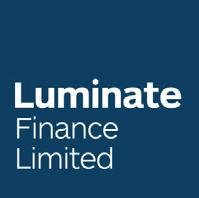
prices and a huge listings overhang, O’Rourke says the Waikato economy – which retracted by 0.3 per cent last year compared to the entire country’s 0.8 per cent drop – has been buoyed by the rural sector, which has an outsized impact on the region.
“Dairy farmers have done well and have another $1.1 billion payout coming. So, there is a degree of confidence because Waikato is still an economic powerhouse in terms of what it produces for the rest of the world, and this passes through to the local economy.”
Hamilton is also still attracting large flows of people from around the country drawn by employment because the city is still finding new jobs, particularly in the tech sector.

“Many tech companies are concentrated on helping the region’s primary producers do things more efficiently around the farm or across the sector as a whole,” O’Rourke says.
Annual change in Hamilton’s median price and sales volumes over five years:
Source: REINZ
Annual change in Hamilton’s sales volumes across price bands over three years:
amount of infill housing, it is likely to taper off from now as it is constrained by council infrastructure.
“There are large portions of the city that are marked red in terms of their development potential, which means that the infill has no choice but to slow down.
“And, as a consequence, investors see those dynamics and go, ‘well, that’s going to put more pressure on housing and therefore rental yields only improve if you can buy today and rents rise in the near future’.”
Mark Laurence from Quinovic Hamilton says Trade Me statistics indicate that the median selling period in Hamilton is 18 days, significantly less than the national median of 22.
“This suggests that Hamilton stock is moving faster than the rest of New Zealand,” he says.
He says that average rent is up on last year across the portfolio.
Source: REINZ
Hamilton’s top 10 suburbs for capital growth in the year ending August 1, 2025:
Source: Cotality
Because of this confidence, investors are recognising the value in Hamilton.
He says Auckland investors are lured by the growth prospects and potentially better yields than they would get in the country’s biggest city. Local investors have also recognised Hamilton’s value and are continuing to add to their portfolios or are new to property investing.
Many are now buying newly built townhouses, which had been the stickiest part of the market for some time.
“We are now getting investors who
are going ‘hey, there is some value in the terraced housing sector’.”
The sales value now exceeds the intrinsic value of that stock, O’Rourke says. Investors are buying at about a five per cent yield.
Big numbers of infill housing, duplexes and terraced houses were built in the past few years, and although the majority have now been finished and are being sold, anecdotally it doesn’t look like Hamilton is rid of its housing crisis. “It still seems to a lot of people are inadequate housing situations.”
While there has been a huge
“Tenancy services market rent data lists Hamilton’s average rent at $560 from bonds lodged; but Quinovic Hamilton’s average rent is $669 from active tenancies,” he explains.
He says that in suburbs such as Rototuna and Flagstaff, solid performers with high supply of modern housing and high demand from families, tenants should expect to pay $700-$750 per week for an average three-bedroom home or $750-$800 per week for a fourbedroom home.
When it comes to yield, Laurence says that investors should expect anywhere between 5-6 per cent for an average priced home.
“A home in Hugh Place, St Andrews sold recently for $435,000 and is currently being advertised for rent at $480 a week, which is realistic.”
But he notes that yields are not as high at the upper end of the market. “A home in Keston Crescent, Flagstaff sold in June for $1,020,000 and rented for $820 per week,” he says. ■
For more information about investing in Hamilton, visit waikatopia.org.nz

Mark Laurence, principal of Quinovic Hamilton and Cambridge, says there is a lot of positivity in the market in Hamilton. He says that Fairview Downs, for example, experienced an 86 per cent increase in online searches according to Trade Me stats in August this year, over last year.
“This suburb is an affordable option that is popular with families. You can expect to pay around $600 per week for a three-bedroom home and $650 for a four-bedroom home.
He explains that the CBD has plenty of one, two and threebedroom apartments and is popular with singles and couples.
“Townhouses are available in the surrounding streets, and these are also popular with professional singles and couples. Modern stock is the most popular with rents on a
modern three-bedroom apartment or townhouse between $700 and $800 per week.”
There has been a small increase in renting time, with the average days to rent moving from 16 last year, to 18 this year, but nothing too significant.
Looking at the rental market nationwide, Quinovic CEO Parrish Wong says that media reporting is not necessarily accurate at a national level – with high vacancy areas being inconsistent across the country.
“The rental glut is completely dependent on what region you are located,” he says.
Using the example of Christchurch, he says there are a number of townhouses and apartments without carparks in Christchurch that are difficult to rent, for example. So it often
comes down to the property itself vs simply the location.
He says that according to their data, both demand for property and rents have remained relatively steady at a national level over the past 12 months
“With over 35 years in the property management industry in New Zealand, we know that these markets are cyclical. That said, adaptation is essential.
“Be proactive in tenant retention. In some cases, clients may need to meet the market on price to secure a tenancy or undertake minor improvements to enhance a property’s appeal to prospective tenants.” ■
DIY Project Alice and Caleb Pearson

Caleb Pearson on ways in which to increase the liveability of your rental property – and encourage tenants to stick around.

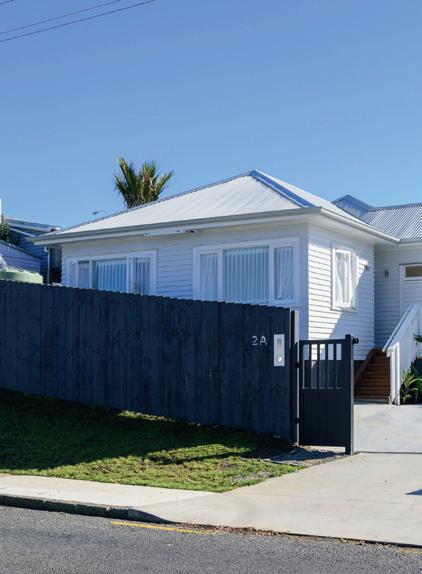



Appealing outdoor areas will help keep tenants happy.
When you’re looking for tenants to live in your rental property, you want someone respectful and reliable, who you know will look after your property, pay on time and give you peace of mind. There are many ways to secure a strong tenant, but once the tenancy is signed, there is real value in keeping them. Long-term tenants who look after your home reduce vacancies, minimise wear and tear, and prevent the need to find replacements. Whilst presentation of a property will encourage people to want to live there, creating a home that people want to stay in will keep them there for longer. Here are the key areas that might be overlooked on signing up a tenant, but will make them want to stay in your property for longer.
Kiwis love the outdoors, so having a usable outdoor area makes your home much more liveable. You don’t need to provide a landscaped masterpiece, but many homes without this will have the area to add a usable outdoor space. A small deck, a paved area, or even just a flat bit of lawn with some privacy goes a long way – preferably linked to an indoor living space. For any of our renovations, adding an outdoor living space is a must. It’s a cost-effective way to add value to your property and provides real practical benefits by adding an extra living area to be used. While big-ticket items get the attention, don’t overlook the small touches, like decent window coverings, good lighting, and ongoing maintenance to prevent wear and tear. If these are not up to scratch, after a year living in your property through the seasons, tenants will know better than you what is up to standard or not.




ABOVE Good security features offer tenants piece of mind and also help to protect your property from unwanted intruders.
It’s easy to opt for the cheapest option when renovating. When we started our first projects, this was our approach because we could not afford anything else. But we have learnt that you get what you pay for. Quality and reliable products will last longer and are nicer to use and often end up cheaper in the long term from less repairs and replacement.
We all want to feel safe in our home – for our families and our belongings. Apart from the obvious requirement of having secure doors and windows, some commonsense upgrades include:
• security lights on sensors on driveway and doors
• security stays on windows, allowing windows to provide fresh air, while remaining secure
• digital door locks
• off-street parking, including or adding an additional off-street carpark will reduce risk to a tenants’ vehicles
• fencing and gate. Fencing can provide comfort and privacy, as well as containment of pets if they have them
• alarms and video doorbells are great additions, but with wireless functions available and subscriptions needed, a tenant may be better suited to install it themselves.
At its simplest, we all want the same thing: a warm and dry comfortable home. The healthy homes standards set out a baseline to achieve this in all rentals, but setting a minimum standard does not mean you need to stop there. Some additional items your tenants will notice.
• A ventilation system makes a noticeable difference to removing moisture in a home.
• Adding heating in bedrooms, which could be as simple as a wall-panel heater on a timer.
• Adding timers on bathroom extract fans, to make sure they remain on automatically to cycle out moisture.
Storage is one of the most underrated features in a rental. It’s not glamorous, but it’s incredibly practical. Tenants might not plan out where all of their “stuff” is stored at a viewing, but once they move in, they will soon find out if it will fit. In our own projects, we’ve often utilised simple and effective storage solutions.
• Wardrobe organisers, add more than just a shelf and a rail, especially in the master bedroom.
• Bathroom storage, whether a cabinet or mirrored cabinet, decent vanity storage.
• A lockable shed is great for larger and outside contents. Bikes, tools, sports gear, gardening items.
• Attic space. An often-untapped location, adding in an attic ladder and some basic flooring can unlock area for those irregularly used items.
Don’t underestimate the value in having good long-term tenants, and how you can achieve this in your property. Creating a home tenants want to stay in isn’t about adding in design trends or constantly upgrading. It’s about thoughtful, practical decisions that make everyday living easier and more enjoyable. If tenants feel comfortable, secure, and proud to live in your property, they’re far more likely to treat it as their home rather than looking for the next place to go. ■























Winter often leaves rental properties in need of attention. And while seasonal repairs and maintenance can feel like just another expense, ignoring clogged gutters, chipped paint, or moisture issues can end up costing even more down the line. A thorough spring reset protects your asset, keeps tenants comfortable, reduces vacancy risk and lays the foundation for a smoothly managed property. There are five reasons why spring is the ideal time to reset.
1. Access: Winter wear is still visible, but summer growth hasn’t taken over yet, making problems easier to spot and fix.
2. Timing for tradies: Tradies book out fast during summer and over Christmas, so securing them now means quicker turnaround times.
3. Optimal weather: Longer, drier days make outdoor work possible with fewer delays.
4. Tenant cycle: Better to get it done now before the tenancy turnover and property market heats up over summer.
5. Prevention: Fixing small issues now reduces risk of them worsening over summer.
For landlords with multiple properties, spring is the most efficient time to clear backlogs, schedule servicing, and get ahead of key maintenance before the summer rush sets in.


The outside of a property takes the hardest knocks over winter, and strategic exterior maintenance delivers immediate visual impact while preventing costly structural issues. Water-blasting surfaces allows moss to be cleared away and removes grime on driveways and footpaths. This makes paths safer underfoot and instantly more appealing.
Exterior paints on south-facing walls and areas around spouting where winter moisture lingers are a good idea; fresh paint protects surfaces and boosts kerb appeal. Loose posts or sagging hinges are small jobs that make a big difference. Winter ground saturation may highlight areas needing repair.
Now is also a good time to prune back overgrowth and remove weeds, top up mulch for a tidy, and
Tidy up your rental’s outdoor spaces after winter to ensure it looks great for the warmer months.
look at creating low-maintenance garden for the summer months. Well-maintained outdoor areas keep tenants happy and protect your property value throughout the summer heat. Here are some quick tips for getting your exterior summer ready.
• Power-wash surfaces and check for loose boards or rot. Re-stain timber if it’s looking weathered.
• Test all outdoor and security lights to ensure bulbs and sensors are working as expected.
• Tighten sagging clotheslines and replace any rusted fittings. Check shed doors open smoothly and locks work properly.
Fresh, well-ventilated spaces keep tenants comfortable year-round and prevent costly moisture damage to your investment. Make sure you check that all windows open smoothly and latches work properly. Ensure security stays allow windows to open safely for summer ventilation.

Make sure your heat pumps and air conditioning are serviced before tenants switch from heating to cooling. Clean filters and confirm systems run efficiently.
You may want to consider swapping heavy winter curtains for lighter options that reduce heat build-up during warmer months. And you should hunt for damp spots from winter and treat any problem areas. Test extractor fans in bathrooms and kitchens are working effectively.
Weather year-round is becoming more unpredictable, so addressing repairs and maintenance early on could be your ticket out of costly repairs down the line. Check all gutters, downpipes and drainage are free from minor blockages.
It’s a good idea to check roofs for cracked tiles, loose flashings, or damaged spouting. Fix small issues now before they become expensive leaks. Now is also a good time to check smoke alarms and ensure insulation remains intact – these yearround requirements should be part of every seasonal property inspection.
‘The outside of a property takes the hardest knocks over winter, and strategic exterior maintenance delivers immediate visual impact while preventing costly structural issues’



A small investment in prevention now saves you from emergency callouts and unhappy tenants later on.
Waterblasting and exterior painting will refresh a tired home after winter.
can take to make your rental more attractive to tenants, and landlords are legally responsible for keeping a property safe and habitable.
A spring reset is the chance to tackle a list of jobs that winter leaves behind; from clearing gutters to servicing heat pumps. Approaching your spring reset systematically can minimise costly surprises, keep your property in top condition, and let you head into summer with confidence and peace of mind. ■
Ticking off your spring reset now not only reduces last-minute maintenance call-outs and prevents Post your job at bc.nz
costly repairs over Christmas, it also gives your property a fresh, wellmaintained look that helps it stand out to tenants and buyers during the busy summer months.
There are plenty of steps you
Builderscrack.co.nz matches property owners that need work done with the right local pros using innovative, patented New Zealand-made tech. From Kaitaia to Bluff, builders to cleaners, repairs to renovations. Done!
The better way to find a tradesperson.

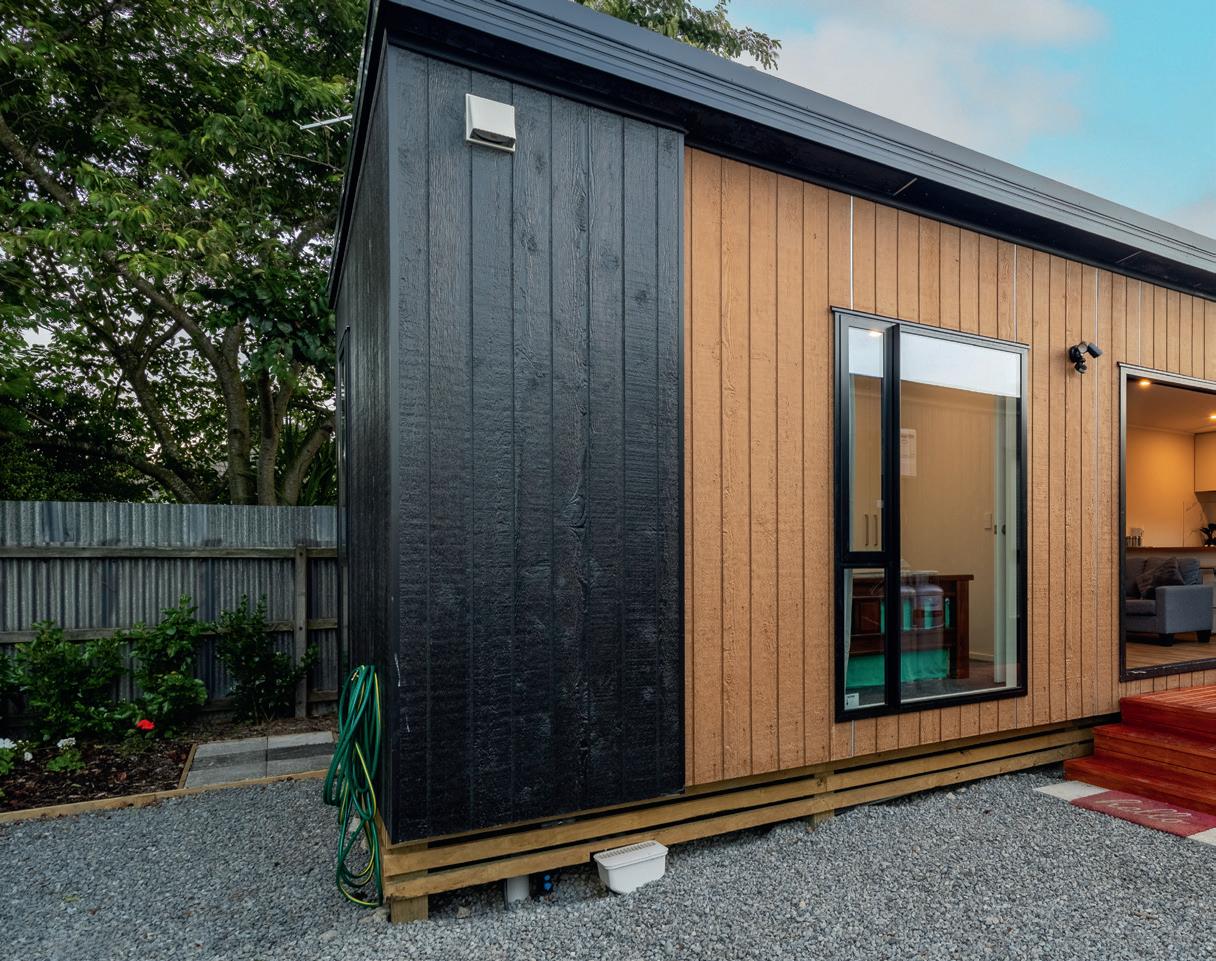
For property investors, there’s no faster way to grow your portfolio than by adding a second dwelling. Whether it’s a compact rental, a minor dwelling, or a larger family home, an additional unit means new income, higher yields, and stronger capital value.
And with the government’s consent exemption for small standalone dwellings (granny flats) expected in 2026, along with zoning changes that allow greater density across major cities, demand for quality minor dwellings is set to increase dramatically.
That’s where Movapod comes in.
Christchurch based Movapod designs and builds high-quality transportable homes. Perfect for investment properties, baches and everything in between.
Every Movapod is architecturally designed, fully compliant, and built in
New Zealand to the same standards as a traditional home. Investors can choose from a range of proven plans, or create a custom design to suit their site and strategy.
Movapods aren’t glorified cabins –they’re homes built to New Zealand’s building code. Constructed with timber framing, full insulation, and doubleglazing, every unit is strong, warm, and designed to withstand local conditions.
This means tenants enjoy the same comfort and efficiency as a traditional home, while investors benefit from peace of mind and long-term durability.
Movapod offers homes from compact 24m2 studios right through to 130m2+ family layouts, giving investors flexibility across every type of property strategy. The most popular option is the 30m2 one-bedroom, priced from
$159,000 and renting for around $400 per week – delivering an impressive 13 per cent gross yield when added to an existing house.
One Christchurch investor added two 30m2 Movapods to the rear of an existing rental property, which had recently been rezoned as RMD. Rather than developing multi-unit housing that would only yield around 6 per cent, they chose the faster and more cost-effective Movapod approach. The total build, including drainage and foundations, cost $330,000 and now returns $800 per week, increasing the property’s yield by 12.6 per cent and lifting its overall market value. With consent and delivery handled by Movapod, the entire process was completed in under four months.
For many investors, the hardest part isn’t the build – it’s knowing what to build, how to add value, and how to navigate the consenting process. The
The most popular option is the 30m2 one-bedroom, priced from $159,000 and renting for around $400 per week.

Movapod team has over 20 years of property investment experience and can guide you through every step, ensuring you make the right decisions to maximise returns.
The process itself is simple.
1. Sign contract + pay deposit – your build begins.
2. 8–10 weeks later – your Movapod is complete and inspected.
3. Delivery nationwide – transported by truck and placed directly on site.
4. CCC issued – 4–6 weeks after delivery, confirming your unit is fully certified.
Movapod also manages resource consents, drainage, power, and foundations – whether wooden piles or screw piles – making the process smooth and stress-free for investors.
A Code Compliance Certificate is issued by your local council once



building work has been completed to the standard required by the NZ Building Code. In short, it’s the council’s stamp of approval that your home is safe, durable, and legally compliant.
Not every modular or transportable building company can provide a CCC. If a company cannot, it’s a red flag that their products don’t meet building code standards. That leaves buyers exposed to risks, including insurance issues, resale problems, or costly remediation work down the track.
With Movapod, the consent is specific to your unit as it leaves the Movapod factory, and the CCC confirms it complies with New Zealand standards. This consent is separate from any site-specific requirements like foundations and drainage, but it means
For more information see movapod.com Phone: 021 220 8521
your unit itself has already passed the most important hurdle.
Every Movapod is architecturally designed, but the look and feel is up to you. Buyers can customise:
• roof style (pitched or flat)
• kitchen layout and colours
• flooring options (carpet or hard surfaces)
• exterior cladding and interior paint colours.
This ensures your Movapod isn’t just functional – it reflects your vision and lifestyle. Whether you’re after a backyard rental, a modern bach, or a compact first home, Movapod makes the process simple, transparent, and compliant. ■
These new builds from Williams Corporation are ideal for those wanting a quality investment opportunity.
Manchester Square, Christchurch, from $649,900
Located in the heart of Christchurch’s revitalised East Frame, Manchester Square comprises stylish one and two bedroom apartments, alongside spacious twobedroom townhouses, all meticulously crafted to high specifications. Importantly for property investors, this complex holds a rare, and highly sought-after, 365-day Airbnb resource consent, allowing full-year short-term rental operation. Positioned steps away from Worcester Street, the Terrace, Botanic Gardens, and the Te Kaha Stadium, Manchester Square presents a turnkey investment opportunity with robust income potential and minimal regulatory barriers, an ideal addition to any high-yield property portfolio.



Wilmer Street, Christchurch, from $489,900
This contemporary development features one-bedroom townhouses and one and two bedroom apartments, all approved for 365-day Airbnb resource consent, offering full-year shortterm rental potential. The apartment building is serviced by an elevator, providing convenient access to upper-level units. Residents and guests can enjoy a resort-style communal leisure suite, including a cedar barrel sauna, a plunge pool, a spa, and external showers, enhancing both lifestyle appeal and investment potential in this central location. Situated in the heart of Christchurch’s Central City, the development offers exceptional connectivity to key attractions. Te Kaha Stadium, approximately 1.2km away, is set to open in April 2026, offering a 30,000 seat capacity for sports and entertainment events; Parakiore Recreation and Sport Centre, expected to open in late 2025, will be the largest aquatic and indoor recreation facility in New Zealand; and Hagley Park, just 1.4km away, provides expansive green spaces for recreation and leisure activities. With such amenities at your doorstep, 20 Wilmer Street presents an unparalleled opportunity for urban living and investment in Christchurch.
Porutu Street, Lower Hutt, from $645,900

This contemporary development offers one and two bedroom townhouses with high-end finishes, all approved for 365-day Airbnb resource consent, providing full-year short-term rental opportunities. Located in the Fairfield area of Lower Hutt, the development is approximately 15km from Wellington’s CBD, offering easy access to the capital’s amenities and employment hubs. Each unit is finished with high-end materials, ensuring a modern and durable living environment. Residents will appreciate the nearby Queensgate Shopping Centre, just a short drive away, offering a wide range of retail and dining options; Epuni Train Station, within walking distance, providing convenient rail access to Wellington City; and State Highway 2, easily accessible for commuting and travel.

Shelly Beach Road, Auckland, from $1,075,900
This exclusive development comprises 18 luxury residences, featuring a mix of one, two, and three-bedroom townhouses, all approved for 365-day Airbnb resource consent, offering full-year short-term rental opportunities. Situated in prestigious Saint Marys Bay, the development is approximately 2km from Auckland’s CBD, providing easy access to amenities and employment hubs. Residents will appreciate the nearby Ponsonby Central, just 1.5km away, offering a vibrant mix of retail and dining options; Westhaven Marina, approximately 1.2km away, providing waterfront leisure activities; and Victoria Park, within walking distance, offering expansive green spaces for recreation and leisure activities. With such amenities at your doorstep, 16 Shelly Beach Road presents an unparalleled opportunity for urban living and investment in one of Auckland’s most sought-after locations.
from $460,900
This boutique coastal development offers one-bedroom townhouses and one and two bedroom apartments, some with direct sea views. Select homes feature allocated off-street car parks, and select units also have resource consents, allowing short-term accommodation for up to 365 nights per year, enabling yearround Airbnb-style letting. All residents enjoy access to a resort-style communal leisure suite featuring a cedar barrel sauna, a plunge pool, a spa, and external showers enhancing both the seaside lifestyle and rental appeal of the waterfront setting. The development presents a compelling mix of location, lifestyle, and shortstay investment opportunities.

Founded in 2012 by childhood friends Matthew William Horncastle and Blair William Chappell, Williams Corporation leverages efficient connection and a shared mindset to drive high business productivity. williamscorporation.co.nz

As the experts at Oyster explain, commercial property investment isn’t out of reach for everyday Kiwis.
Commercial property investment is something most people assume is for the top end of town; those with large amounts of capital to invest. The reality: thousands of everyday New Zealanders already co-own some of the country’s largest office, industrial and retail assets through experienced unlisted commercial property fund managers like Oyster Property Group.
Not just for
Buying a shopping centre, warehouse, or office building outright is well beyond the reach of most investors.
But through unlisted property funds, individuals can pool their capital and take a share of large-scale assets.
The properties Oyster owns, for example, include Central Park, an award-winning office precinct with the celebrated Green Food and Beverage Precinct; and Millenium, a large corporate campus in Auckland’s suburb of Ellerslie.
The difference is in the structure and strategy. Instead of one owner taking on all the capital and management responsibility, a fund spreads those across tens, hundreds or thousands of investors. And experienced managers take care of
the asset strategy, leases, financing, compliance, and maintenance – while investors share in the rental income and long-term capital gains that can come hand-in-hand.
These aren’t niche properties. They’re the supermarkets you shop in, the logistics hubs moving online orders, the large business parks that are home to leading New Zealand and international entities and quality office buildings in strategic CBD and city fringe locations.
Commercial property generates
Commercial property can include business parks, offices, retail and industrial assets.

returns in two ways: rental income and long-term capital growth. Unlike residential property investments, commercial leases are typically longterm, which helps create consistent, contracted income.
Many leases also include fixed annual increases or CPI-linked reviews, so rental income doesn’t just hold its value – it often rises with inflation. It’s one of the few asset classes where inflation protection is built in.
It’s an ownership model designed around stability, not short-term trading; so a long-term view is critical to maximising the growth potential of this asset class. You’re not just relying on the market to lift the value – you can earn income along the way, with the potential for capital growth over time.
Direct ownership comes with constant decisions: finding tenants, negotiating leases, arranging debt, dealing with councils and repairs. Unlisted funds strip that away. Investors don’t need to be landlords; they simply share in the results of smart acquisitions and professional management.
It’s not about making property simple – it’s about buying into an asset with a strong investment strategy in place that will be managed on their behalf by an experienced team.
The typical investor in an unlisted fund isn’t a property mogul (though property moguls do take advantage of

‘Thousands of everyday New Zealanders already co-own some of the country’s largest office, industrial and retail assets through experienced unlisted commercial property fund managers like Oyster Property Group’
the management benefits of unlisted property funds too).
They’re everyday New Zealanders. Retirees looking for income. Families building diversified savings. Professionals setting long-term goals. First-time property owners taking a different route. The investor base is broad, mainstream, and steadily growing.
For many, property funds offer a middle ground: direct enough to feel connected to real assets, but professionally managed so they don’t have to worry about the day-to-day.
Commercial property has long been a staple in diversified investment portfolios for investors seeking to grow their wealth over time – but it doesn’t need to be out of reach. Unlisted funds provide access to the same scale and stability institutions rely on, through a model built for individual investors.
Commercial property has long played a part in strategic, diversified
investment portfolios. Unlisted commercial property funds offer a straightforward way for individual investors to access the large-scale assets that would be out of reach on their own.
As with any investment, there are considerations. Liquidity is more limited than in other investment classes like the share market. Returns are built steadily over time rather than in quick bursts and investors need to buy in with a long-term horizon in mind.
But for investors seeking long-term exposure with built-in resilience, they offer something rare – real assets, real income and a strategy built to keep earning through all parts of the economic cycle.
The door is open.
To learn more, visit oystergroup.co.nz or contact the Oyster Investor Relations team on +64 9 281 4460


Residential property has been the ‘darling’ of New Zealand property investments, but should it be? Carol Pedder investigates.
For decades, New Zealanders have had a love affair with the “darling” of New Zealand investments, residential property – and why wouldn’t they?
Residential property offered favourable tax outcomes. The entry point to purchase was usually lower than commercial property. Tenants were plentiful, and there was always a demand if you needed to sell. Lending was obtainable at residential rates, and if you were good at DIY, you could add value to your investment.
In comparison, commercial property was perceived to be riskier. There were more challenging finance terms to meet with lending being subject to commercial interest rates with shorter loan terms. Plus, there was the real fear of the property being vacant for a long period of time when the lease ended or if the tenant was unable to meet their obligations under the lease.
But over the past decade, residential property has become more and more political. Residential investors have increasingly felt the financial impact of legislation changes that were created to dampen the appetite for residential investment.
The bright-line test with its complicated rules for roll-over relief, interest-deductibility restrictions, loss ring-fencing rules and the removal of depreciation for buildings have all reshaped the residential investment landscape.
‘Both types of investment, residential or commercial, have their own unique risks and benefits’
Some of these issues have been eased by the coalition government, with the brightline test being reduced from 10 years, back to two, and interest deductibility now phased back in over the last three years. However, with an election just around the corner in 2026, many residential investors are understandably apprehensive that these restrictions could be reintroduced.
In comparison, it could be said that commercial property, from a political and tax perspective, is now becoming the more attractive of the two, given the certainty it provides in terms of the taxing rules applicable to it.
The political tampering in the property tax rules has been mainly limited to residential property, with the bright-line test, interest deductibility limitation and loss ring-fencing never being applicable to commercial property.
In addition, there is a larger scope for depreciation with the ability to depreciate commercial fit-out. Commercial property has a wider range of chattels and depreciable
items that can be depreciated compared to residential properties. Other benefits of commercial property investment include higher yields compared to residential property. Commercial leases are often “net” of costs, where residential investors have the burden of all expenses. Plus, longer lease terms with a quality tenant provide income stability and predictable cash flow.
For investors looking to diversify or grow their property portfolios, understanding these differences and selecting the type of investment that is best suited to your financial goals is essential. Both types of investment, residential or commercial, have their own unique risks and benefits. Securing professional advice before you purchase your investment ensures your investment is not only commercially sound, and meets your requirements, but is also tax-efficient.
At PKF Withers Tsang we work alongside investors to navigate these differences. Regardless of the challenges, property remains a viable investment option for the building of long-term wealth. ■

Leonie Freeman, chief executive of Property Council New Zealand, says that government reform of consenting and liability will create a fairer and faster development ecosystem.

The recent announcement by the government to reform both building consenting and liability settings marks a significant step toward creating a faster, fairer, and more consistent development ecosystem. For property investors, these changes have the potential to reduce costs, remove delays, and create greater certainty when navigating New Zealand’s complex consenting regime.
For too long, our building system has been hamstrung by inefficiencies. Sixty-six different councils, each operating their own Building Consent Authority (BCA), means 66 different interpretations of the Building Code.
It’s no wonder developers, builders, and investors alike are frustrated. What may be approved in one district can be declined in another, adding unnecessary risk, time, and cost to projects.
The government’s move to enable voluntary consolidation of BCAs is an important step. A smaller number of consenting authorities, working regionally, could bring a more streamlined and consistent process. For investors, that means fewer surprises, faster approvals, and a clearer pathway to delivering housing stock. Of course, the success of this reform will depend on councils recognising the need for change and working together.
The second major reform – moving from joint and several liability to proportionate liability – tackles one of the root causes of delay. Under the current system, councils are often left as the “last man standing” when defects arise. Even if their contribution was minor, they’ve carried the bulk of liability, leaving ratepayers footing the bill. Unsurprisingly, this has made councils highly risk-averse, slowing down the consent process and stifling innovation.
Proportionate liability changes that. It spreads accountability across the entire construction pipeline, from designers and engineers through to contractors and developers,

rather than unfairly burdening local authorities. This should give councils more confidence to sign off building work without fear of being left holding the can, ultimately speeding up consenting decisions.
For property investors, the flow-on effects are significant. Faster consenting means projects can progress without costly delays. More balanced liability means a fairer system where everyone involved in the construction process takes
‘A smaller number of consenting authorities, working regionally, could bring a more streamlined and consistent process’
responsibility. And with councils under less pressure, we can expect a more pragmatic approach to approvals.
That said, the detail will matter. We look forward to clarity on mechanisms such as professional indemnity insurance and home warranties as signalled by the government. These tools will be crucial in ensuring accountability while providing investors and homeowners with the certainty they need to move ahead with confidence.
It’s also worth noting that these reforms build on earlier government commitments to broaden access to new and alternative building products from overseas. This is particularly encouraging. By opening the door to trusted products from global markets, we can lower construction costs and introduce new solutions that benefit both developers and homeowners.
Ultimately, what does this mean
for you as an investor? It means a more predictable environment in which to plan your projects. It means less red tape, fewer delays and a more consistent set of rules across the country. It means councils are no longer incentivised to delay or overcomplicate consent decisions out of fear of liability. And most importantly, it means progress toward a building system that is fit for purpose in the 21st century.
The property sector has long called for change, and this package delivers a pragmatic start. It doesn’t solve every issue overnight, but it represents a real shift toward a building system that is faster, fairer, and more accountable. If implemented well, these reforms could unlock new opportunities for residential investors while helping New Zealand tackle its housing challenge.
For investors, certainty is everything. This announcement gives us more of it, and that can only be a good thing. ■
Property Council is the leading advocate for Aotearoa New Zealand’s largest industry - property.
We unite more than 10,000 property professionals and 550+ member companies to champion reduced red tape, encourage investment, and support thriving communities.
Our diverse membership includes New Zealand’s largest commercial, industrial, and residential property owners, developers, investors and associated professionals. They come together at more than 80 annual events and through the DevelopU training academy, which provides professional development, exceptional networking opportunities, and access to industry-leading insights.
As a not-for-profit organisation, we’re dedicated to building a stronger future for New Zealand’s property sector. Together, shaping cities where communities thrive.
Property Council New Zealand is the one organisation that collectively champions property. We bring together members from all corners of the property ecosystem to advocate for reduced red tape that enables development, encourages investment, and supports our communities to thrive.


When buying a property in New Zealand, a land information memorandum (LIM) should be high on your due diligence checklist, writes Paul Money of Land Law NZ.
LIMs include a wide range of information about a specific property including zoning, rates, hazards, consents, and compliance issues. But while a LIM can be incredibly useful, it’s not a panacea.
The biggest advantage of a LIM is that it gives you a consolidated snapshot of a property. Instead of chasing down details from different council departments, you get a single report that pulls it all together. That alone can save you hours of research and a fair bit of frustration.
But the real value lies in what the LIM can reveal. Here are some of the key things it covers:
Building consents and compliance. The LIM will summarise whether the structures on the property have the right consents and meet current regulations. If there are any unapproved additions, or dodgy alterations that the council is aware of, they will be in the LIM.
Zoning and planning rules. Advice on the zoning for the property and what you can do with it. This will determine if the property is suitable for your intended use.
Essential services. It includes information on mains water, stormwater, and wastewater connections, plus any known issues like flooding or poor drainage, including computer modelling on overland flow paths.
Land hazards. Erosion, subsidence and contamination risks based on past use. The LIM will also flag natural risks that could affect your insurance and therefore your ability to obtain mortgage finance.
Rates and charges. This will detail what the current rates for the property are, and whether there are any arrears.

Resource consents. Details of any existing consents for things like subdivisions or engineering works.
Council notices. Any outstanding notices, such as a notice to fix, will be disclosed, giving the purchaser information on potential compliance issues.
All of this will assist the purchaser to make informed decisions. If the LIM reveals issues, the purchaser can use this information to negotiate a lower price or request that the vendor remedy any defects before settlement, or in the event the issues are serious enough, cancel the contract and walk away from the purchase.
‘A LIM has limitations and being aware of these limitations is an important part of conducting your due diligence correctly’
In Auckland, where properties can sit on flood plains, or be subject to special overlays, a LIM is especially valuable. It can highlight risks that aren’t obvious by viewing the property in person.
A LIM has limitations and being aware of these limitations is an important part of conducting your due diligence correctly.
Firstly, a LIM is based on the information the council has at the time it’s requested. A LIM is not based on any physical inspections by council, but purely on council records and data. Therefore issues like a leaky roof, faulty plumbing or unconsented work will not be in the LIM unless the council has been formally notified. So, a complete due diligence on a property should also include a building inspection by a qualified professional.
Not all LIMs are the same. While most councils follow similar guidelines, the level of detail can vary. If buying in Auckland, the purchaser should become familiar with what the Auckland Council typically includes in a LIM so they know what to expect.
The LIM is only current as of its issue date. If a new zoning rule comes into effect or there’s a flood the day after the LIM is issued, that won’t be reflected in the LIM. Timing is important so don’t rely on an old report.

Be aware that a LIM provided by a vendor or real estate agent, and not ordered by the purchaser directly, will mean the purchaser may not have legal standing if the LIM has an error or omission. The purchaser would not be able to sue the council because they had no contractual arrangement with the council. The best way to mitigate this risk would be for the purchaser to order their own LIM from the council and get legal advice before relying on any documents supplied by a third party.
Getting a LIM before buying property will always be recommended by your legal adviser. It gives you a clearer picture of what you’re getting into and helps the purchaser identify any red flags. From zoning and consents to issues with the land and council notices, it’s a useful tool for making informed decisions, and possibly avoiding a costly mistake.
Remember, a LIM should only be part of the purchaser’s due diligence. A LIM doesn’t replace a building inspection, and it doesn’t cover everything. It should be part of a broader due diligence investigation that includes legal advice and a physical inspection of the property.
By understanding both the strengths and limitations of a LIM, the purchaser will be better placed to make an informed decision about purchasing the property. ■
There are compelling reasons why New Zealand needs property management regulation, says registered property valuer Eve Prouse.

The only thing worse than having a bad tenant is having a bad property manager. For too long, property management in New Zealand has operated in a largely unregulated environment. While investors are required to follow extensive rules and tenants have growing protections, the professionals tasked with managing these relationships remain outside any formal regulatory framework. It’s time for that to change.
Property managers have a fiduciary duty. They are responsible for safeguarding one of the most significant financial assets a person can own, while also ensuring tenants are treated fairly and legally. Regulation will not only protect investors’ interests, but it will also keep property managers accountable,
uphold professional standards, and rebuild public trust in an industry that too often makes headlines for the wrong reasons.
As a valuer and landlord, I’ve seen firsthand the damage that poor property management can cause. In one instance, a tenant was storing a dirt bike in a bedroom and justified it by saying it was “like an internal garage”. In another case, tenants painted Christmas decorations directly on to tinted windows and failed to remove them until the end of their tenancy, causing unnecessary damage.
Overcrowding is another recurring issue. I’ve encountered a two-bedroom flat rented to two named tenants but occupied by at least five people. Such
neglect not only increases wear and tear but also places the tenants’ health and safety at risk. Without regulation, property managers who allow or overlook such breaches face no real consequences.
The introduction of the healthy homes standards demonstrated how regulation can lift standards across the board. While the rules aren’t perfect, they created a baseline that forced landlords to improve insulation, ventilation, and heating. Today, tenants and buyers alike expect a property to have at least a heat pump, insulation, and adequate ventilation, what once seemed like “extras” are now seen as essentials.
For investors, compliance is also
‘The introduction of the healthy homes standards demonstrated how regulation can lift standards across the board’

about protecting long-term value. Properties that fall short of the standards risk fines and, importantly, reduced value when prospective buyers calculate the cost of retrofitting. Regulatory frameworks give clarity and consistency, helping to set market expectations and prevent corners from being cut.
Regulation in property management would create ripple effects beyond the profession itself. For investors it ensures that property managers are qualified, accountable and operate with transparency. Investors could have confidence that their asset is in capable hands and that mismanagement won’t erode returns.
For self-managing landlords it sets an example. Just as healthy homes lifted expectations for private landlords, regulated property management would encourage better practices across the rental sector.
For tenants, regulation reduces vulnerability. Some tenants are unaware of their rights or lack the resources to challenge poor treatment. Regulation provides them with a safeguard against exploitative practices.
If we are to regulate property managers, it follows that Kāinga Ora, one of the largest landlords and property managers in the country, must also be held accountable. The same standards that apply to private investors should apply to state-
managed housing. Anything less risks undermining the credibility of the system.
Another area where regulation could make a real difference is in the treatment of non-compliant dwellings. I regularly inspect illegally converted garages that are rented as “extra accommodation”. No matter how much money has been spent on renovations, – a new bathroom, insulation, even a heat pump – if the council does not recognise it as habitable, it cannot legally be rented as such.
These grey-area rentals not only put tenants at risk but also mislead investors about potential income streams. Regulation of property management would bring muchneeded clarity, preventing these kinds of risky practices from being normalised.
Property management in New Zealand is at a crossroads. The industry can either continue as it is, with inconsistent standards and little accountability, or it can embrace regulation and step into its rightful place as a respected profession. Regulation will protect investors, improve outcomes for tenants, and create consistency across the rental market.
Ultimately, regulation is not about creating red tape, it is about raising the bar. As property investors, we rely on managers to protect our assets, uphold our reputations, and deliver steady returns. It is only fair that we demand the same standards of professionalism, accountability, and trust that we expect in every other service that handles our financial future. ■
Eve Prouse is a registered property valuer and founder of Eve Prouse Property Valuations Limited, specialising in Auckland’s diverse property landscape, particularly South Auckland. Known for her sharp market insights and community-rooted approach, Eve is a respected media commentator and champion of inclusive, family-friendly business practices. For more of Eve’s expert tips you can follow her at @eveprousepropertyvaluations or her website eveprouse.co.nz

Trent Bradley from Luminate on the secret retention fees banks don’t tell you about.
Most property investors are familiar with cash incentives and legal fee contributions banks offer to win new lending. But fewer realise that banks will also pay you just to stay put. These payments, called retention fees, are becoming a powerful – and often under-discussed – part of the mortgage game.
In today’s competitive lending environment, banks are prepared to pay to protect their loan books. If you’ve got $2 million in borrowing with bank A and you’re tempted by a bank B refinance offer, bank A may counter with a 0.3 per cent to 0.5 per cent cash payment (sometimes tens of thousands of dollars) simply to keep you from moving. That’s real money in your pocket and understanding how to use retention fees wisely can make
a huge difference to your long-term property finance strategy.
Advisor tip: Always remember, retention fees aren’t advertised. You only get them by asking – or by having an advisor negotiate on your behalf.
A retention fee is a cash payment a bank makes to persuade an existing client to stay rather than refinance elsewhere. It’s a defensive move, designed to protect the bank’s loan book from competitors. Unlike upfront legal contributions or cash incentives (paid when you join a new bank), retention fees are about loyalty – or more accurately, about reducing churn.
The size of the retention fee typically depends on:
• Loan size: The bigger your borrowing, the more valuable you are to the bank.
• Competition: If another bank is offering 0.7–1 per cent to poach your lending, your current bank may match part of that to keep you.
• Market conditions: When loan growth slows, banks are more generous in retention negotiations.
Advisor tip: Don’t assume you need to threaten to leave before a bank offers a retention fee. A skilled broker can signal you’re shopping around and trigger an offer without burning bridges.
Retention fees can be extremely attractive for savvy investors.
• Immediate cash in hand: A 0.3–0.5 per cent retention fee on a $2 million portfolio is $6,000–$10,000 cash to stay with the status quo.
• No need to move banks: You avoid the hassle of refinancing, shifting accounts, and updating automatic payments.
• Leverage without commitment: By showing you’re considering alternatives, you can create a bidding war between banks –sometimes extracting both sharper interest rates and cash.
Advisor tip: Retention fees work best when you genuinely are prepared to move. Banks can sense when the threat is hollow, so keep your refinancing options real and documented.
While tempting, retention fees aren’t always the best answer. Key pitfalls include:
• Smaller than switching incentives: Banks usually pay less to keep you than competitors will to win you.
• False sense of savings: Investors sometimes fixate on the cash payment and ignore interest rate differences.
• Negotiation fatigue: Accepting a retention fee may mean you miss the opportunity to restructure lending with another bank, free up equity, or improve long-term terms.
Advisor tip: Always run the numbers over the fixed-term horizon. A $6,000 retention fee today is meaningless if it costs you $16,000 extra in higher interest over three years.
It’s worth distinguishing between retention fees and the more familiar incentives for new business.
• Legal contributions: Small amounts ($1,000–$1,500) designed to cover solicitor fees when shifting banks.
• Cash contributions: Larger payments (0.7–1 per cent of loan size) to win new clients.
• Retention fees: Smaller payments (0.3-0.5 per cent) to defend existing relationships.
Each has its place. For many investors, a cash contribution to switch is financially superior. But when speed, convenience, or simplicity matter, retention can be a clever middle ground.
Advisor Tip: Use your scale. If your portfolio is large, banks will sharpen their pencil. Even a modest 0.1 per cent improvement in rate on $2 million dollars of lending dwarfs a retention fee in long-term value.
Not every borrower is eligible for a retention fee. Banks are selective in deciding who to pay, and they weigh up both risk and competitive pressure before making an offer. In practice, here are the key factors they consider:
1. Out of prior incentive terms: If you’ve already taken a cash contribution in the last 24–48 months, you’ll usually need to wait until that period has expired before the bank will consider paying you again.
2. Solid account conduct: Your accounts should be in good order: no dishonours, no arrears, and timely loan repayments. Strong conduct makes it easier for a banker to justify a retention offer internally.
3. Floating or about to float: Retention fees are most often offered when loans are coming off a fixed rate and about to roll onto floating. That’s when you’re “in play” and most likely to shop around.
4. Stable security and risk profile: The property or portfolio securing your lending needs to remain the same or similar to what the bank already holds. If your risk profile has worsened, the bank is less likely to pay you to stay.
5. Market appetite and competition. Banks vary in how aggressive they are. When competition is fierce, offers become more generous. In quieter periods, they may pull back.
Advisor tip: Don’t assume eligibility is automatic. Even if you tick all
Trent Bradley is a mortgage advisor and property investor. He has owned and operated Luminate Financial Group for over 26 years, a financial advisory service specialising in property investors.
the boxes, banks won’t volunteer a retention fee unless you (or your advisor) put competitive pressure on the table.
1. Trigger competition without moving Use a competitor’s offer as leverage to get your current bank to pay you to stay. This creates value with minimal disruption.
2. Stack the deal Don’t settle for just a retention fee. Ask for a sharper rate or better structure alongside the cash. Banks often concede more than one lever to keep your business.
3. Play the timing game Retention fees are cyclical. When credit growth slows or when a bank’s loan book is under pressure, offers become more generous. Work with an advisor who knows the cycles.
Advisor tip: The most powerful way to win with retention is to treat it as one tool in your kit – not the only option. Always compare side-by-side with switching incentives and long-term rate savings.
For New Zealand property investors, retention fees are a little-known but increasingly valuable lever. Banks are willing to pay to keep your business – but the amounts, timing, and terms vary widely. The key is to stay informed, keep competitive offers on the table, and work with an advisor who can crunch the numbers and negotiate firmly on your behalf. Handled well, retention fees can be more than a consolation prize –they can be a cash-flow boost that strengthens your portfolio and keeps you one step ahead of the banks.
At Luminate Finance, we specialise in helping investors unlock every advantage, from retention negotiations to restructuring strategies, ensuring you always maximise value from your lending relationships. ■


Shadi Salehpour gives her perspective on the change of pet rules in rentals.
It’s a windy Sunday here in Auckland.
The olive tree outside my office scrapes against the building, and I sit with a hot cup of tea and two Auckland Council animal management reports, 2023 and the latest, June 2025.
Working in South Auckland, roaming dogs are a reality, and I’ll admit, being nervous at inspections is too. When I arrive at a property, I’m loud, keys rattling, “Hello, Shadi here for inspection!” Because this is the tenants and their dogs’ territory, their home. If they’ve forgotten I’m coming, if the dog is loose, or if a guest doesn’t know why I’m there, I don’t want surprises. I want to leave safe.
The council’s data explains why. Dog attacks on people are up, roaming complaints increased by 11 per cent, and shelters are at capacity with a record 60 per cent euthanasia rate. While registration compliance has improved to 88.4 per cent, these numbers tell us that irresponsible ownership has real community consequences. Will it get better with new pet rules coming in? Or if people have more freedom to get pets, will these numbers get worse?
And then there are the surprises you never expect. I’ll never forget the tenant who kept a goat, yes, a goat at a residential property on Becker Drive in Weymouth. At first it was funny, then it was “oh no!” It went from being cute to me wondering, how on earth am I going to tell the landlord? Our agreement said no pets, that meant dogs and cats. It was a perfect reminder of the unpredictable challenges landlords face when animals become part of a tenancy. From chewed fences to lingering smells, pets of all kinds can leave their mark.
The Residential Tenancies Amendment Act 2025 (RTA) will soon reshape this landscape. Tenants will need landlord consent for pets, landlords may refuse only on “reasonable grounds,” and pet
‘The real issue isn’t pets versus no pets, it’s responsibility’
bonds of up to two weeks’ rent will be allowed. Tenants will also be liable for damage beyond fair wear and tear. It’s an attempt to balance tenants’ desire for pets with landlords’ right to protect their investment. But the RTA’s favourite colour (grey) remains; what exactly counts as reasonable grounds?
I’ll be upfront, I’m not really a dog person, probably due to the trauma caused being chased and bitten by a golden jackal when I was a child. I also find the smell of dogs in a property overwhelming. Sorry but not sorry to dog owners, there is a distinctive smell in homes that have dogs. No amount of toxic chemicals from Glade plug ins will make it go away.
Still, I acknowledge that while an investment property is first a business asset for a landlord, it is also a tenant’s home. If a dog or cat is part of that home, then let it be. The reality is that wear and tear happens. Nothing against kids, but I’ve seen children cause more damage than pets. Pets don’t draw on walls or spill Fanta on the carpet. The real issue isn’t pets versus no pets, it’s responsibility. The trick is picking responsible dog owners with well-trained animals, just as we select tenants who will respect the property.
For landlords, the best protection lies in clear, enforceable agreements:
• strong pet clauses in tenancy agreements, (not contracting outside the RTA)
• pet bonds applied consistently
• seeking evidence of training, desexing, and registration
• careful tenant selection
Because at the end of the day, it’s not really about the goats, dogs, or cats.
It’s about people, and whether they take responsibility for what they bring into a home.
I am not against pets in rentals, but only if there are clear conditions in place.
Carpets must be professionally cleaned at the end of tenancy, at the tenant’s cost. Pest control must be done professionally at the end of tenancy. If a pet is aggressive, it must be removed from the property during inspections. Landlords and property managers must have easy access to the “pet bond” if needed.
Be confident despite these changes, a skilled property manager should be well equipped to pick the right tenant application.
At the start, when you market the property, you can always choose an applicant with no pets (did I say that out loud?) But under the new rules, a tenant could request a pet after being granted the tenancy. That creates another layer of uncertainty.
An interesting question for you, what happens when a unit is in a body corporate that allows pets for owneroccupiers, but not for tenants in the same building? Can the RTA overwrite those body corporate rules? I would love some feedback on this.
I’ll leave you with this thought as I make another cup of tea (the first has gone cold). I find myself remembering more details of the time the jackal bit me. My parents had told me to stay close, but we wandered off. A lesson learned, in property, as in life, we can’t avoid every surprise or laws forced on us, but we can prepare with rules, responsibility, and a little caution. ■
Let’s Rent is an award-winning property management company in Auckland dedicated to providing exceptional service for landlords, property investors and tenants. Founded on the principles of integrity, personalised service, and attention to detail, Let’s Rent stands out for its innovative approach to property management. letsrent.co.nz

Debbie Roberts of Property Apprentice on how financial advice is essential for property investors wanting to map out their future.
On the surface, property investing can look pretty straightforward. Get a bank to lend you some money, sign a few forms, and boom – you’re a property investor! And, sure, if you can secure the lending required, you absolutely can buy a property. Unfortunately, that does not mean it will be a good investment.
“Buy a house, rent it out, and watch your wealth grow.” If it really were that easy, there’d undoubtedly be a lot more successful property investors (and a lot fewer who have lost money).
A property might look appealing, be in a great neighbourhood, or even seem like a good deal. But its suitability as an investment will depend entirely on how well it aligns with your current financial position and goals. Without a clear understanding of what this means for you, you’re essentially gambling with your finances.
Property investing is not always easy, but it is pretty simple – when you know how to do it properly.
While New Zealand property has shown strong long-term growth historically, we’ve certainly also experienced some significant decreases in property values across New Zealand over time. For example, following the Asian financial crisis, the global financial crisis, and more recently, after the global pandemic (Covid-19). Although most economists are expecting property values to increase over the next few months/
years, you have no control over capital growth, so it would be foolish to base your purchasing decisions purely on potential future capital growth. What goes up can and will hit periods of flatness – or even decreasing values – before the next period of capital growth.
Building your entire investment plan on something you can’t control is a recipe for stress, disappointment and sometimes even bankruptcy.
The real skill in successful property investment lies in understanding the fundamentals. It’s not just about how much you pay for the property; it’s about the rental demand and rental return (gross yield and net yield), the cash flow (what comes in and what goes out), the potential in the deal (or lack thereof), and the likelihood of long-term capital growth (is the property in an area that supports the fundamentals for this?).
A property might have good potential for capital growth, but if its monthly costs are considerably higher than the rental income, it could quickly become a financial drain. Negative cash flow can eat away at your financial stability (especially if your primary income source is affected, e.g. through redundancy or business closure), turning something you thought was an asset into a genuine liability. The
art of property investment is finding a property that supports your financial well-being while also building your wealth over the long term.
Successful property investment is not a game of Monopoly; it’s a game of finance.
The days of buying as many properties as you can and expecting capital growth to do the heavy lifting are long gone. It calls for a robust financial strategy tailored to your personal circumstances, a clear understanding of what you can borrow, and an honest look at how much it will cost and the level of risk you’re comfortable with. It’s about being meticulous with your due diligence, and not using “hope” as a strategy.
So, is property investing easy? The act of buying a property can be (especially when the banks are keen to lend and when there are plenty of properties available to buy). But successful property investing – the kind that genuinely builds lasting wealth and financial freedom –demands discipline, planning, and a solid grasp of financial and economic principles (or a great team of professionals to support your journey).
If you’re serious about growing your wealth, don’t cut corners. Cutting corners can cost you tens (or hundreds) of thousands of dollars.
The financial rewards of doing it properly are absolutely worth the effort. If you want help with this, you know where to find us. ■



Anna Sedakova from myRent on the fresh wave of technology that is revolutionising the property space.
Not long ago, managing a rental meant endless spreadsheets, phone calls, and paper forms. Today, a new wave of prop-tech companies – unburdened by tradition – is rewriting the rulebook. They’re asking a simple question: what if property management didn’t have to be so complicated?
From insurance to inspections, the new standard is clear: faster, simpler tools that cut admin and free up time for what really matters.
Collaboration, not competition is vital. In the past, these kinds of innovations often emerged in silos. Today, the real progress comes

from collaboration. We’re now working alongside others to build smarter, tech-enabled property management together.
Initio Insurance has brought a no-nonsense approach to landlord and house insurance. For decades, landlords accepted that claims were slow and paperwork-heavy. Initio has flipped the script; its model is built around saving time for everyone involved, and giving investors
confidence that when things go wrong, they won’t be stuck in an endless process.
Renti is redefining tenant onboarding. Instead of tenants spending hours on hold setting up utilities, Renti handles the admin and unlocks deals you can’t get direct. The result: tenants walk into a property that’s connected and ready from day one.
myInspections is tackling one
myRent.co.nz is New Zealand’s leading platform for self-managing landlords, helping tens of thousands of property investors stay compliant, organised, and in control. From listing to agreements, inspections to maintenance, myRent supports every step of the rental journey.
‘From insurance to inspections, the new standard is clear: faster, simpler tools that cut admin and free up time for what really matters’
of the most time-consuming jobs: inspections. The app makes it easy to create consistent, detailed reports without inflated fees or unnecessary complexity. It’s free for individual landlords and a smart add-on for managers with larger rent rolls who want a faster, more professional inspections process.
What ties all of this together is a shift towards putting customers first. These companies aren’t competing to own the whole process, but creating tools that connect.
At myRent, we’ve taken the same approach: focusing on core services like advertising, rent collection and compliance, while leaning on partnerships with companies like initio, Renti, and myInspections to deliver value in areas where they excel. Together, this ecosystem makes property management simpler, faster, and ultimately more rewarding for landlords and tenants alike.
The momentum in prop tech isn’t slowing down. What’s clear is this: the future won’t be defined by one platform trying to do it all, but by an ecosystem of connected services. Collaboration – not competition – is resetting the standard for what good property management looks like. And that standard is rising fast. ■

New pet rules come into play shortly and landlords are well advised to consider this an opportunity to grow their tenant pool and reduce churn, writes Sarina Gibbon .
In a few short weeks, tenants are expected to have the presumptive right to have pets. Presumptive, as in rebuttable, so long as the landlord acts reasonably. As tempting as it is to luxuriate in the smug banality of talkback outrage, the smart play would be to recognise the new risk and model accordingly. Pet rules done properly grow your tenant pool and reduce churn. This is nothing to do with your ongoing philosophical jostling with wokedom; this is about achieving operational excellence for your rental business.
From the roll-out (which will be by Order of Council, expected sometime this year), tenants can request consent to keep pets in writing, and you must reply within 21 days. You can refuse
on reasonable grounds, or consent with reasonable conditions. A separate pet bond of up to two weeks’ rent (one bond per tenancy, not per pet) becomes collectable and is lodged alongside general bonds.
Before the roll-out, there could be no pet bond (assuming you’ve already collected the maximum four-week bond). But you can explore a s28 uplift in rent with the tenant’s agreement or the tribunal’s blessing. A measured increase paired with the stickiness of pet-owning tenants can very well outperform a two-week bond later. Bolting on a rent uplift after the rollout will likely be unreasonable and unenforceable.
The Act gives examples of both
reasonable grounds and reasonable conditions. In light of s85, you should treat them as signposts, not shields. Whatever your decision, it must still be objectively reasonable in the context of the tenancy, the property, or the pet. Fundamentally, we cannot escape the fact that the Tribunal is one of the few judicial forums with the power to dispense with legal formalities and rule on the merits of substantial justice if your refusal or your conditions are more performative than proportionate... good luck.
Barfoot & Thompson’s 2023 portfolio analysis shows a real weekly uplift for pet-friendly homes across a large sample. In tight sub-markets, scarcity does the heavy lifting, and the gap

widens. Though premium is not always guaranteed, when policy, product and process line up, it shows up on the P&L (read: market segmentation). Exploiting loopholes so you could keep saying no to pets will shrink your customer base and force you to compete on price. Build a pet-ready product to target a bigger and often underserved market segment with pricing power.
In my advisory work, I regularly encounter landlords who confuse compliance theatre with strategy. It isn’t. The fix is choice architecture: set strong defaults and pathways so sensible outcomes happen quickly, consistently and with minimal risk. Keep it high level and tight.
1. Reasonable grounds matrix: A simple one-pager in plain English. Decide yes or no on proven facts, not speculation.
2. Conditions ladder: Scale conditions to the actual risk of the pet to the property. If you can’t monitor a condition, don’t write it.
3. Light friction, smart signals: Ask for simple, objective proof where relevant and keep the experience fast for responsible applicants. Be consistent. Do not improvise.
That’s the practical and granular playbook that lives inside your rental business.
If you can’t substantiate it, don’t include it. If you can’t enforce it, don’t impose it.
Zero damage in the new (pet) world order is a fantasy with a high price tag. What compounds returns is tenure length and lower churn. Pets are a commitment device. Pet owners are less mobile than non-pet owners. It’s not just the house. Its proximity to critical amenities, communities and the social network. It’s the voo-voo magic that makes a morning jog on Takapuna beach a non-negotiable for Henry, the retriever. One extra week of vacancy eclipses a lot of incremental wear. Instead of fretting about every scratch, design your business for predictable costs and your property for expected wear. Hard-wearing surfaces in traffic zones, washable paint at waist height, secure fencing where appropriate, and pre-agreed end-of-tenancy cleaning if pets are indoors. No, the chihuahua isn’t having one over you; you are just being a prudent asset manager.
Commercialise pet-readiness. Package upgrades you already understand as a no-brainer value-add for tenants: durable floors, easy-to-clean finishes, a hose point in the garage to rinse off Lassie, screen guards near sliders, and a map callout to nearby green spaces. Present a coherent, higherutility experience and price the rent accordingly.
Templates are stationery, not strategy Commercial “pet clauses” and
templated “no pets” workarounds are popping up all over the place. They promise control but actually deliver exposure.
The way I see it, these are untested sales copy masquerading as case law when all the RTA is asking you to do is figure out what is objectively reasonable for this tenancy. Their one-size-fits-all nature blinds users to the context, and reasonableness is nothing if not contextual. I call them the Ozempic of tenancy law. Sure, you feel safe now, but when the effect fades, you are back to being bloated and RTA-vulnerable. It’s high time this industry stops buying comfort and starts building confidence.
Still, I am not your mother. If you still want to use a template, use Tenancy Services’. It’s not glossy for sure, but in terms of enforceability at the Tribunal, it is the closest thing you will come to a safe harbour.
I get it. It’s not everyone’s cup of tea. If you still feel resistance and resentment, run the “five whys”. If by why #3 or #4 the answer is “no pets because pets”, you know you’re not managing a business risk, you’re indulging in a bias that won’t stack up against the presumptive right framework or an 85 merits check. Reset to facts and follow the playbook:
• Treat pets as a priced, managed segment with real demand elasticity.
• Use section 28 carefully before roll-out, where the variation truly benefits the tenants.
• After commencement, rely on the pet bond and proportionate conditions. Avoid creative fees.
• Replace blanket bans with a reasonable grounds matrix and replace performance rules with a conditions ladder.
If you want the full playbook drilled and ready for day one, join my Fur Real training between 6 and 10 October. Details are on tenancyadvisory.co.nz. We turn ‘no pets because pets’ into a system you can run at scale. ■
Sarina Gibbon is an independent tenancy advisor with clients ranging from the Auckland Property Investors Association, Renti and several property management companies.

The NZPIF awards reward landlords who raise the standard when it comes to providing quality homes to Kiwis.
Each year, the NZPIF awards give us a chance to celebrate the effort our members put into providing quality homes and building positive relationships with tenants. This year we received more applications than ever before, showing how committed our community is to raising the standard.
The awards are not about quick fixes or checking compliance boxes. They recognise landlords who care about the people in their properties and who invest time and energy into creating homes that tenants can genuinely enjoy.
The renovation category this year showcased some impressive transformations. We heard about homes that went from tired and outdated to warm, healthy and modern. Some were large-scale projects that completely reimagined a property, while others focused on smaller but impactful changes that made life easier and more comfortable for tenants.
What came through strongly this year is how tenants respond to those efforts. Many landlords told us that their tenants take more pride in their homes after upgrades, caring for them as if they were their own. It is
THANK YOU FOR

‘Many landlords told us that their tenants take more pride in their homes after upgrades, caring for them as if they were their own’
gestures go beyond the basics of renting and show how much of a difference a thoughtful landlord can make.
Tenant feedback backed this up. Many spoke about feeling valued, listened to and treated with fairness. These are the stories that highlight what good landlording looks like, and it is encouraging to see so many NZPIF members leading by example.
a reminder that good renovations benefit everyone: they add value to the property and they improve everyday living for the people who call it home.
The Rentskills category showed the value of strong tenant relationships. We heard about landlords whose tenants rarely move on because they feel supported and respected. Others make the effort to ensure a smooth start, offering welcome packs or simply being responsive from day one.
We also saw examples of landlords helping new arrivals to New Zealand settle in, offering advice on schools, transport and local services. These


This year’s record number of applications tells us something important: landlords across New Zealand are stepping up. They are improving homes, supporting tenants, and showing pride in the role they play in providing housing.
To everyone who applied, thank you. Your stories highlight the positive work happening across the country and the high standard our members set.
We will be celebrating our finalists and winners at the NZPIF Conference. If you are already thinking about applying next year, start collecting your stories now. Whether it is a renovation project or the way you support tenants day to day, your efforts deserve recognition.
This year’s record entries show how much NZPIF members are achieving, and we cannot wait to see even more stories in next year’s awards. ■





NORTHLAND
NEXT MEETING: October 27, 2025. 7pm
Monthly round-up of events and meetings at our property investor associations.
AUCKLAND
NEXT MEETING: Go to www.apia.org. nz/events for details on upcoming meetings. APIA hosts 100 events and presentations for its members each year.

WAIKATO
NEXT MEETING: October 10-12, 2025
TOPIC: NZPIF Property Investor Conference – Innovation 2025.
NEXT MEETING: October 21, 2025 @ 7:30pm at Plymouth
International Hotel, 220 Courtney St, New Plymouth
TOPIC: Contact taranaki@nzpif.org.nz for more information about this meeting.
NEXT MEETING: October 1, 2025 @ 7:30pm at 54 Pascal St, Palmerston North TOPIC: Sponsors and trades night.
MARLBOROUGH
NEXT MEETING: TBA
TOPIC: Contact marlborough@nzpif.org.nz for more information about this meeting.
NEXT MEETING: TBA
TOPIC: Contact nelson@nzpif.org.nz for more information about this meeting.
SOUTHLAND
NEXT MEETING: TBA
NEXT MEETING: Monday, October 13, 2025 @ 7pm at Tauranga Club, Level 5, Devonport Towers, 72 Devonport Road
TOPIC: Contact tauranga@nzpif.org.nz for more information about this meeting
NEXT MEETING: October 14, 2025 @ 6pm at NZHL office, 1109 Fenton St.
TOPIC: Discover how relocatable homes can add value, boost rental income, and simplify your next project. Cost-effective, fast, and proven.
NEXT MEETING: October 20, 2025 @7pm at Taradale Town Hall, Meanee Rd, Taradale TOPIC: Bitcoin/crypto night.
NEXT MEETING: October 23, 2025. Lone Star Masterton, 49 Dixon St, Masterton TOPIC: Join us for the October meeting of the Wairarapa Property Investors Association. Whether you’re just starting out or an experienced investor, these monthly catch-ups are a great way to stay informed and connected.
NEXT MEETING: October 9, 2025 @ 7pm at Lifepoint Church, 61 Hopper St, Mount Cook, Wellington
TOPIC: From finding the deal to sealing it: Tama will walk through real-world examples of how he sources, analyses and negotiates investment properties in today’s market.
CANTERBURY
NEXT MEETING: October 22, 2025 at Hotel Elms, Papanui Rd, Christchurch
TOPIC: Social housing.
SOUTH CANTERBURY
NEXT MEETING: October 15, 2025 @ 7:30pm at Caroline Bay Community Lounge, Timaru Port, Timaru
TOPIC: Contact south-canterbury@nzpif.org.nz for more information about this meeting.
NORTH OTAGO
NEXT MEETING: TBA
TOPIC: Contact northotago@nzpif.org.nz for more information about this meeting.
OTAGO
NEXT MEETING: TBA
TOPIC: Contact southland@nzpif.org.nz for more information about this meeting.
TOPIC: Contact otago@nzpif.org.nz for more information about this meeting.
TOPIC: Contact northland@nzpif.org.nz for more information about this meeting. Join a property investor association for industry updates, networking and commercially independent information – a great way to protect your rental property investment.


Three days of inspiration, learning and connection at New Zealand’s leading event for property investors.
Hosted by the Waikato Property Investors Association, this year ’ s conference is all about fresh thinking, practical insights, and shaping the future of property investment
Featured Highlights:
Dynamic sessions with leaders in property, construction, regulation and finance Hear from innovators like Craig Shannon (Zuru Tech), Shane Brealey (Simplicity Living), Ministers Tama Potaka and David Seymour, and economic expert Kelvin Davidson (Cotality) Hosted by Conference MC and comedian Jan Maree
Unique field trips and bus tours, giving you access to cutting-edge projects and technology. Visit a 3D-printed home with Qorox, explore factory-built transportable housing at BUILTsmart, see sustainable Metra Panel in action, and view modern minor dwellings and show homes from Compac Homes and Iconic Plus a special stop at Bunnings to see new products, meet their Trade Team, and enjoy a classic sausage sizzle
Sponsor exhibition where you can explore the latest products, services, and tools that support successful investing
Masquerade Gala Dinner – a glamorous night of entertainment, awards, and prizes, sponsored by Initio Insurance


Oct/ Nov 2025

The key to any good Investment is Information. NZ Property Investor magazine, with the trusted data supplied by Corelogic would like to show you how you could use this data to optimise your next investment search.
1
Compare rents and values for 3 and 4 bedroom houses in a given suburb
Then consider what the rent and value increase would be if you renovated a 3 bedroom property into a 4 bedroom property. Example: Manurewa North going from 3 to 4 beds, looks like an increase of about $200,000 and rent of about $80 a week.
2

Estimate an increase in rent from a renovation
Example: If my house is in Manurewa North and has 3 bedrooms. If it currently rents for $590 and has 3 bedrooms, a renovation could push it up the rental range to the upper quartile. Currently $670. That’s an $80 increase. Estimate the 1 year increase. This can also be useful when estimating how the value of your property may have changed over the prior 12 months, which can then impact your ability to purchase your next property.
3

Estimate rental demand and how long it will take to find a tenant For instance there were 48 bonds issued in Dinsdale South in the last month. That means there are about 12 3-bed houses renting in that suburb per week. That might tell you something about how much vacancy you might have.



- Paremata/Mana/ Pukerua














The






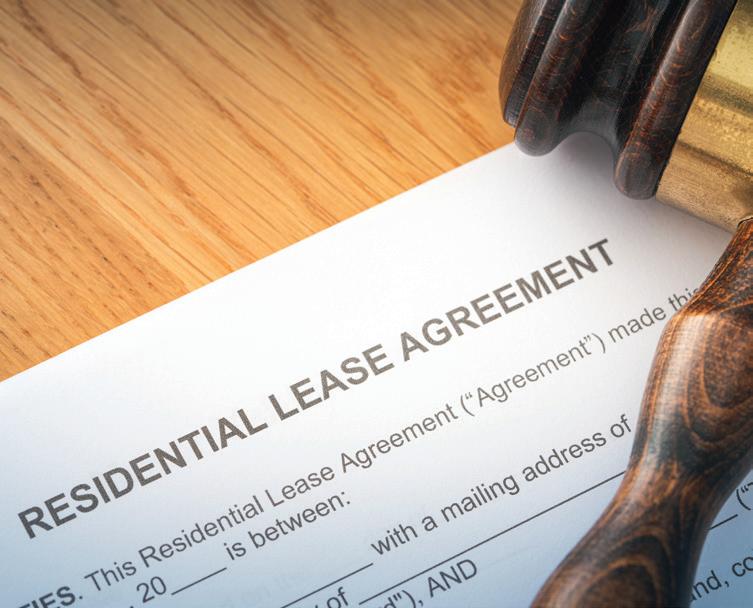
The Tenancy Tribunal is under pressure, with some experiencing waits of ten weeks or more. David Faulkner says there is a simpler way.
It was refreshing to read the Tenancy Tribunal’s annual report, published by new principal tenancy adjudicator Brett Carter, who states that one of his goals is to enhance further public understanding of how the tribunal works. It’s great to see this level of transparency from an institution that often gets a bad rap.
The 2024 annual report shows progress, but delays in securing a hearing remain the biggest issue. Timelines have stretched from six weeks in 2021 to ten weeks in 2024, driven by a surge in applications following Covid.
Interestingly, the data reveals a sharp drop in rent-arrears applications during the Covid-19 lockdown periods – particularly in Q2 and Q3 of both 2020 and 2021. This wasn’t due to a sudden improvement in tenant payment behaviour, but rather the result of emergency amendments to the Residential Tenancies Act.
During the pandemic, the government introduced a rent freeze, eviction ban and longer notice
periods to protect tenants. Landlords, however, were unable to pursue rent arrears through the tribunal, leading to fewer applications.
While these changes were necessary at the time, they also highlighted how legislative levers can dramatically influence tribunal activity. As we move forward, we should consider how similar mechanisms – such as streamlined processes for simple cases – could be used to improve efficiency in non-crisis times.
Remote hearings now account for 52 per cent of all cases, and we are seeing a gradual increase in applications made to the tribunal. The tribunal’s increased use of remote hearing technology is a step in the right direction. It saves time, reduces costs, and makes the process more accessible. But we need to go further.
FastTrack resolution – where parties agree on rent arrears, bond, or water payments and have their agreement formalised without a
hearing – is underutilised. The tribunal itself admits public awareness of FastTrack is limited. Promoting this option more aggressively could significantly reduce the number of cases requiring full hearings.
In 2024, there were 29,309 tribunal applications, with 12,799 requiring a hearing. Encouragingly, over a quarter were resolved at mediation, with nearly 90 per cent of those settled. The lesson is clear – landlords and property managers should front-foot disputes early, as timely intervention reduces the need to go to tribunal.
Given the volume and simplicity of many rent-arrears cases, we should explore a system where certain claims can be resolved without a hearing. If the evidence is clear and uncontested, why not allow adjudicators to make decisions based on the paperwork alone?
The recent legislative change allowing “decisions on the papers” is a promising development, but it’s currently limited and cautiously applied. Expanding this to include basic rent-arrears claims – especially where tenants do not respond – could dramatically speed up the process.
As we look to the future, we must ask whether artificial intelligence (AI) could play a role in resolving tenancy disputes. Could we reach a point where AI systems, trained on thousands of past tribunal decisions, could make rulings on simple cases like rent arrears or bond refunds?
While we must tread carefully –natural justice demands that parties are heard and decisions are fair – the potential for AI to assist adjudicators, streamline processes, and reduce human workload is enormous.
AI has a role to play in freeing up time for adjudicators, but we must not forget that these decisions significantly impact people’s lives. We need to strike the right balance between the law and the empathetic needs of both parties. We encourage a collaborative approach between key stakeholders and the tribunal to explore ways to improve its effectiveness. ■

Funds available for non-consumer loans, up to 24-months fixed rate from 9.95%p.a.
No Reg. valuation required
Any location in New Zealand
No consumer lending
Capitalised interest available
Residential, commercial and rural
No SOP required

Henderson, Auckland
Finbase is a non-bank lender, offering tailored loans for property investors, developers, and traders, providing swift funding without main bank restrictions.
We offer advances up to $2.5 million without income verification. Finbase provides first ranking mortgage funding for short-term property projects, with a maximum loan term of 24 months.
Lending available up to 70% LVR of property.

Recently funded investments: Mangere, Auckland Security
Security
Value: $2,956,521
Purpose of funds: Equity release to repay existing lenders Exit strategy: Sale of security property
We assess loans based on LVR and the individual deal. We require first mortgage security over the property and a clear exit strategy.
Security description: 98m² dwelling, on a circa 610m² section
Purchase price: $705,500
Purpose of funds: Funds required to settle the purchase Exit strategy: Refinance to a main bank

Finbase offers several types of loans including bridging finance, property trading finance, and equity release.
